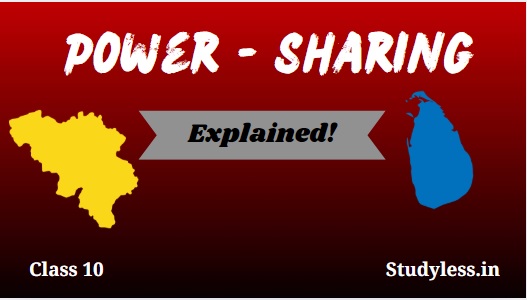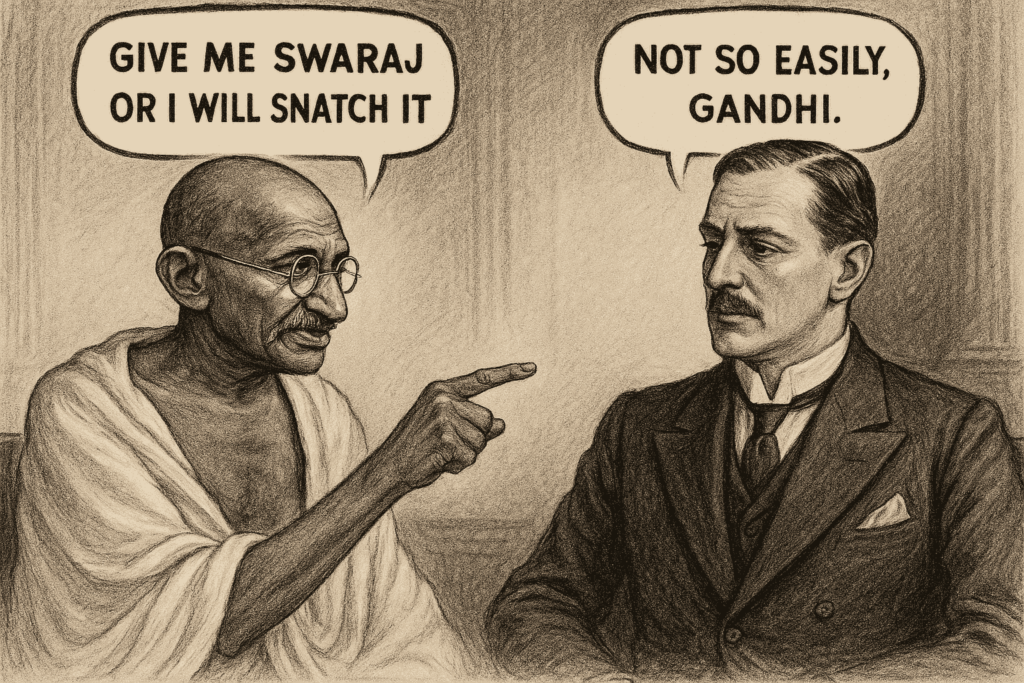
🎯 What Made Indians Say, “Enough is Enough”?
Imagine your school suddenly bans all Indian festivals but allows British-style parties. Everyone—Hindus, Muslims, Sikhs—would unite to protest, right?
That’s how Nationalism in India began!
🌍 British policies like heavy taxes, forced indigo farming, and the Rowlatt Act (which allowed arrests without trials) made Indians realize: “We’re not servants in our own land!”
Table of Contents
Food for Thought:
If you were a farmer forced to grow indigo instead of food, how would you react? 🤔
💥 World War I: The Ultimate Betrayal
During WWI (1914–1918), the British said, “Help us fight, and we’ll give you self-rule!” Indians sent soldiers, money, and supplies. But after the war? The British said, “Just kidding!” 😡 This betrayal was like your parents promising a phone for topping the class… and then gifting socks. 🧦
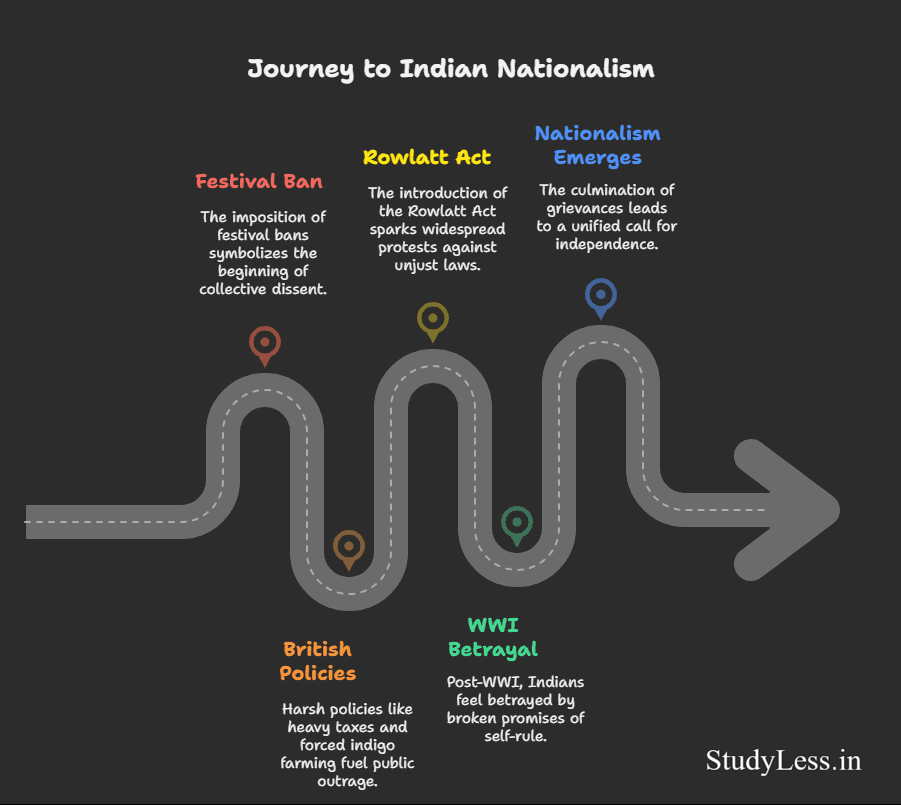
Think Deeper:
Why do broken promises hurt more than no promises at all?
🌍 Nationalism in India: A Unique Story
You know how European nationalism was about creating nation-states with flags and anthems? India’s nationalism was different—it was born out of a fight against British rule! 🛑 Just like your school project group unites to finish a tough assignment, Indians discovered their shared identity while resisting colonialism.
Wait, how?
British policies made farmers, workers, students, and traders all feel equally oppressed. Think of it like a strict teacher punishing the entire class for one mistake—it forces everyone to team up! But here’s the twist: each group had different struggles and dreams of freedom.
Fun Fact:
Rabindranath Tagore’s song “Jana Gana Mana” (our national anthem!) became a glue for unity. 🎶 Imagine singing it with strangers and feeling like family!
🧩 Why Was Indian Nationalism Special?
In Europe, nationalism = creating new countries. In India, nationalism = kicking out the British AND figuring out what “India” meant. 🤯
Let’s Break It Down:
- Anti-Colonial Bond: Fighting the British was like a school-wide protest against unfair exams—it united everyone, even if some wanted grace marks and others wanted cancelation!
- Different Dreams: A farmer wanted lower taxes, a factory worker wanted better wages, and a student wanted freedom to speak. Gandhi’s Congress tried to mix all these into one movement. 🗣️
Thought-Provoking Question:
Can unity survive if people want different things? (Think of your group projects! 💬)
📜 From Europe to India: Nationalism’s Journey
Let’s compare!
| European Nationalism | Indian Nationalism |
|---|---|
| Built nation-states (e.g., Germany, Italy) | Fought to free one existing nation |
| Used flags, anthems, history books | Used protests, charkhas, salt marches |
| Unified people through culture | Unified people through shared pain |
Did You Notice?
India’s nationalism was like a patchwork quilt—different fabrics (cultures, languages) stitched together by colonialism’s needle. 🧵
🔥 The Big Challenge: One Movement, Many Voices
Gandhi’s Congress was like a WhatsApp group with 100+ opinions! 😅
- Peasants wanted tax cuts.
- Workers demanded fair wages.
- Elites desired power-sharing with the British.
Conflict Alert!
Unity didn’t mean agreement. For example:
- Some wanted to boycott British schools; others said, “But we need degrees!” 🎓
Debate Time:
Is it better to have a united movement with compromises or many small movements focused on specific goals?
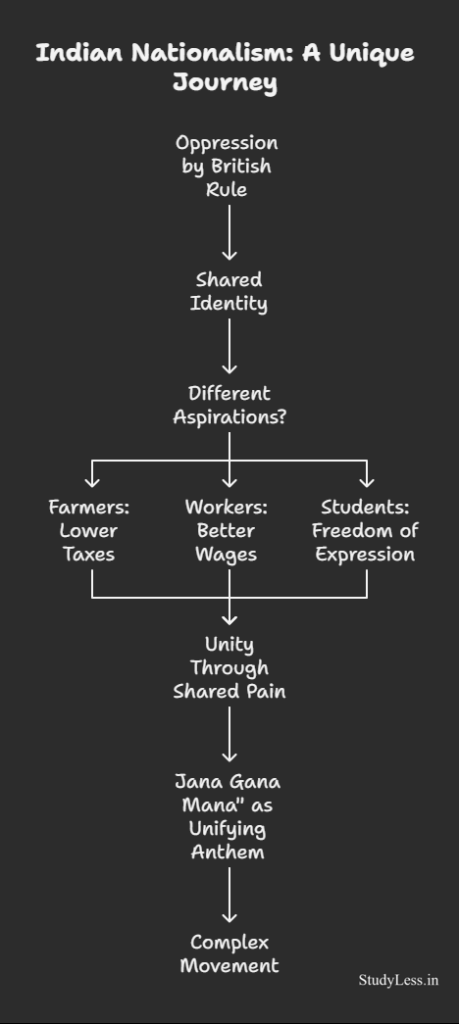
🕰️ Flashback Alert!
In earlier classes, you saw how nationalism grew till the 1900s—partitions, Swadeshi movements, and anger over World War I. Now, we’ll dive into the 1920s–1940s: the era of Non-Cooperation, Civil Disobedience, and Gandhi’s epic strategies!
Fun Analogy:
If India’s freedom struggle were a movie, the 1920s would be the plot twist where the hero (India) stops begging and starts fighting! 🎥
🔍 Quick Check: Are You With Me?
MCQs (Pick Wisely!):
- Indian nationalism grew mainly because of:
a) Love for British tea
b) Shared struggle against colonialism
c) A desire to copy Europe
Assertion & Reason:
- Assertion: The Congress united different groups under one movement.
- Reason: All groups had the same demands.
Short Questions (1 Line!):
- How did colonialism act as a “shared bond” for Indians?
🌱 Gandhi’s Role: The Ultimate Mediator
Gandhi ji was like the captain of a chaotic cricket team 🏏—managing batters (farmers), bowlers (workers), and wicketkeepers (lawyers). His goal? Turn their anger into a non-violent force strong enough to shake the British Empire!
Quote to Ponder:
“Freedom is not worth having if it does not include the freedom to make mistakes.” – Gandhi
Would you follow a leader who allows mistakes?
🚀 What’s Coming Next?
Hold on! We’re about to explore the Non-Cooperation Movement—where students boycotted schools, lawyers quit courts, and everyone said “Bye-Bye British Goods!” 👋
Imagine your class refusing to attend school until the canteen serves better samosas. That energy—but on a national scale! 🔥
Ready to dive into the 1920s? Let’s unravel how Indians turned anger into action! 💪
🌍 World War I: A Bombshell on India’s Economy & Mood
Picture this: Your principal suddenly announces a “War Tax” on your pocket money to fund a school competition. Then, your canteen prices double! 😱 That’s how World War I (1914–1918) hit India. Let’s break it down:
- Empty Pockets, Empty Stomachs:
- The British borrowed huge loans for the war (💸) and made Indians pay via new taxes (income tax + customs duty).
- Prices of food, cloth, everything DOUBLED between 1913–1918. Imagine ₹50 samosas! 🥟
- Forced Recruitment = Village Anger:
- British officers dragged villagers like “free delivery soldiers” to fight in WWI. No consent, no respect! 😠
- Double Disaster:
- 1918–1921: Crops failed + deadly flu epidemic hit. Result? Over 12 million deaths (like wiping out Mumbai + Delhi’s population!). 😷
Fun Fact (with a Dark Twist):
The 1918 flu was nicknamed “Spanish Flu”—but it didn’t even start in Spain! 🤯
📉 After the War: Broken Promises, Rising Anger
Indians hoped the British would say “Thank you” post-WWI. Instead, they got:
- No reforms.
- More taxes.
- No relief from famine.
Relatable Alert:
Ever helped a friend move houses, and they didn’t even offer chips? That’s how India felt! 🥺
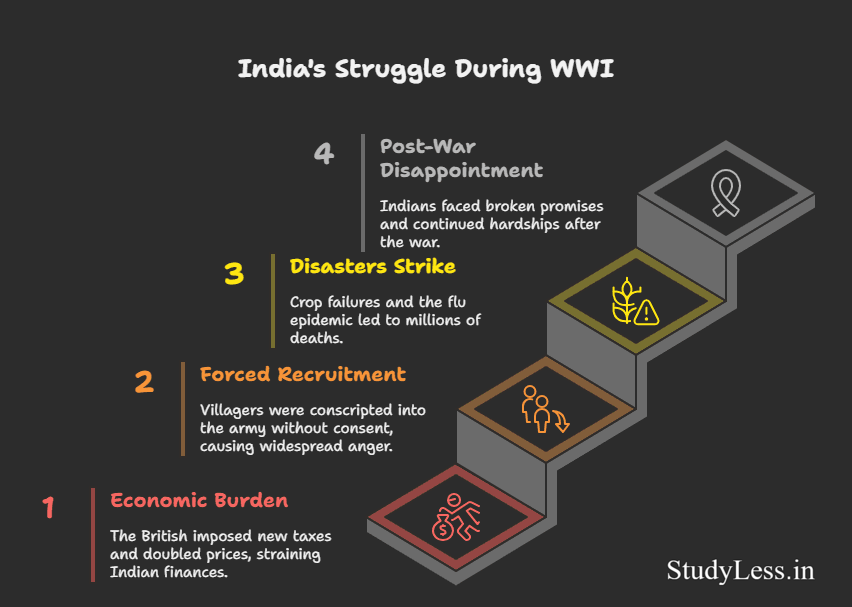
🧩 How Did This Spark a National Movement?
The war’s aftermath was like gasoline on fire! 🔥 Different groups joined hands:
- Farmers: Fed up with taxes.
- Workers: Sick of low wages.
- Students: Tired of foreign rule.
But wait! Something was missing… A leader who could unite them all.
🌟 Enter Gandhi: The Game-Changer!
In 1915, Gandhi returned to India from South Africa. By 1919, he was ready to flip the script! His new weapon? Satyagraha (truth + firmness).
First Moves:
- 1917: Champaran Satyagraha (fought for indigo farmers).
- 1919: Kheda Satyagraha (helped drought-hit peasants).
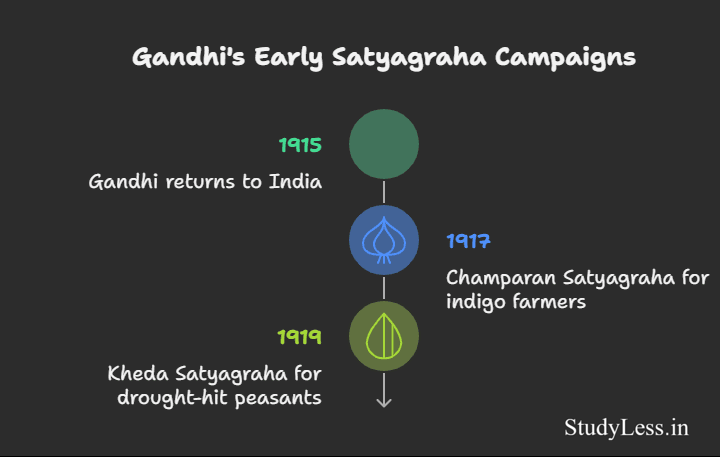
Quote to Ponder:
“The best way to find yourself is to lose yourself in the service of others.” – Gandhi
How can YOU serve your community?
📊 WWI’s Impact: A Snapshot (Table Time!)
| Problem | Effect on India |
|---|---|
| War Loans & Taxes | Prices doubled; people starved |
| Forced Recruitment | Villages rebelled against British |
| Crop Failure + Flu | 12–13 million deaths (Census 1921) |
Brain Tickler:
Why do you think the British ignored India’s post-war suffering?
🔍 Quick Check: Did You Grasp the Crisis?
MCQs (Choose the Truth!):
- What caused prices to double during WWI?
a) Magic
b) War loans + taxes
c) Aliens
Assertion & Reason:
- Assertion: Forced recruitment made villagers hate the British.
- Reason: Villagers loved joining the army.
Short Questions (1 Line!):
- Why was the 1918–1921 period called a “double disaster”?
🚀 From Anger to Action: The Khilafat-Non-Cooperation Alliance
Gandhi saw a golden chance! The Khilafat Movement (1919–24)—where Muslims protested the British removing the Ottoman Caliph—became his ally. Together, Hindus + Muslims launched the Non-Cooperation Movement (1920):
- Boycott schools, courts, foreign goods.
- Surrender titles (like “Sir”).
Thought-Provoking Question:
Can religious unity survive political goals? (Hint: We’ll find out later!)
🌱 What’s Next? The Magic of Satyagraha!
Gandhi’s Satyagraha wasn’t just protests—it was soul force. But how did it work? Why did it inspire millions? Let’s unravel this superpower of truth in the next chapter! ✨
Teaser:
Imagine convincing your entire school to boycott exams peacefully. Could you do it? 🤔
Ready to unlock Gandhi’s playbook? Let’s dive into Satyagraha—where truth meets courage! 💪
🌟 Gandhi’s Superpower: Satyagraha!
Imagine if you could defeat a bully without throwing a single punch! That’s exactly what Satyagraha (truth + firmness) was—a moral superpower Gandhi ji brought to India from South Africa. ✨
How it worked:
- Fight injustice with truth, not violence.
- Make the oppressor feel guilty by staying calm and brave.
- Win hearts, not wars!
Gandhi’s Big Idea:
“Even the toughest heart can melt if you show truth with courage!”
🌾 Champaran Satyagraha (1917): Farmers vs. Forced Indigo!
Scene: British officers forced Bihar farmers to grow indigo (used for dye) instead of food. 🌿
Gandhi’s Move: He arrived, lived in villages, and said, “Stop this unfair system!”
Result: British had to pass the Champaran Agrarian Act—farmers could grow food again! 🎉
Fun Fact:
Gandhi was arrested here but said, “Jail is my holiday home!” 😂
💧 Kheda Satyagraha (1917): No Crops, No Tax!
Crisis: Gujarat’s Kheda faced floods + crop failure. Farmers couldn’t pay taxes! 🌧️
Gandhi’s Strategy: Peaceful protest + refusal to pay.
Victory: British relaxed tax rules for poor farmers!
Quote to Chew On:
“When the people lead, the leaders will follow.” – Gandhi
🏭 Ahmedabad Mill Strike (1918): Workers Unite!
Problem: Mill workers got low wages (like getting ₹10 for a ₹100 job!).
Gandhi’s Trick: He fasted (hunger strike) to pressure mill owners.
Outcome: Workers got a 35% wage hike! 💰
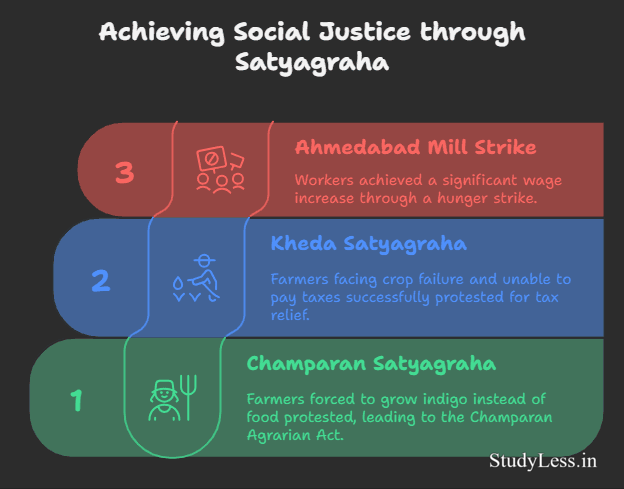
Relatable Analogy:
It’s like your parents agreeing to raise your pocket money after you calmly explain your needs!
📊 Gandhi’s Early Satyagrahas: A Quick Table
| Movement | Year | Issue | Result |
|---|---|---|---|
| Champaran | 1917 | Forced indigo farming | Farmers’ rights restored |
| Kheda | 1917 | Unfair taxes during famine | Tax relief for farmers |
| Ahmedabad Mills | 1918 | Low wages for workers | 35% wage increase |
Brain Tickler:
Why did Gandhi choose non-violence over anger? Would you do the same?
🔍 Quick Check: Are You a Satyagraha Pro?
MCQs (Choose Wisely!):
- Satyagraha means:
a) Violence for truth
b) Truth + non-violence
c) Begging for rights
Assertion & Reason:
- Assertion: Gandhi used fasting in Ahmedabad.
- Reason: He wanted to scare mill owners.
Short Questions (1 Line!):
- How did Champaran farmers benefit from Satyagraha?
💡 Why Satyagraha Shook the British?
Violence makes you look like the “bad guy.” But Satyagraha exposed British cruelty without giving them excuses to retaliate. It was like winning a chess game with patience, not punches! ♟️
Thought-Provoking Question:
Can silence be louder than screams?
🔥 What’s Next? The British Strike Back!
The British hated Satyagraha’s power. So, they made the Rowlatt Act (1919)—a law to arrest Indians without trial. 😱
Imagine your school principal suspending you without listening to your side! That’s how India felt.
Teaser:
Next, we’ll see how this Black Act sparked the Jallianwala Bagh massacre and united India like never before! 💔
Ready to uncover the Rowlatt Act horror? Let’s dive into how British cruelty fueled Nationalism in India!
🚨 The Rowlatt Act: Britain’s “Black Law”
Imagine your school principal suddenly announces: “Anyone questioning my rules will be suspended without an explanation!” That’s exactly what the Rowlatt Act (1919) did—it gave the British power to arrest Indians without trial for 2 years! 📜💔
Why was it unfair?
- Passed despite Indian leaders’ protests.
- Meant to crush protests and silence voices.
- Gandhi called it a “law meant to destroy liberty.”

Fun Fact:
Indian members of the council voted unanimously against it—but the British ignored them! 😤
✊ Gandhi Strikes Back: Rowlatt Satyagraha
Gandhi ji declared a nationwide hartal (strike) on 6 April 1919.
- Shops closed, factories halted, cities froze! 🛑
- Peaceful rallies, strikes, and protests erupted.
But the British panicked!
- They arrested leaders like Dr. Saifuddin Kitchlew.
- Banned Gandhi from entering Delhi.
Relatable Analogy:
It’s like your parents grounding you before you even do anything wrong!

💔 Jallianwala Bagh: A Day of Blood and Tears
13 April 1919: A crowd gathered in Amritsar’s Jallianwala Bagh for Baisakhi fair and protest.
- General Dyer blocked exits and ordered troops to fire. 🔫
- 400+ killed, 1,200+ injured—many jumped into a well to escape bullets.
Shocking Quote from Dyer:
“I wanted to teach them a lesson… to strike terror.”
Did You Know?
The well in Jallianwala Bagh is still a haunting reminder. 💧
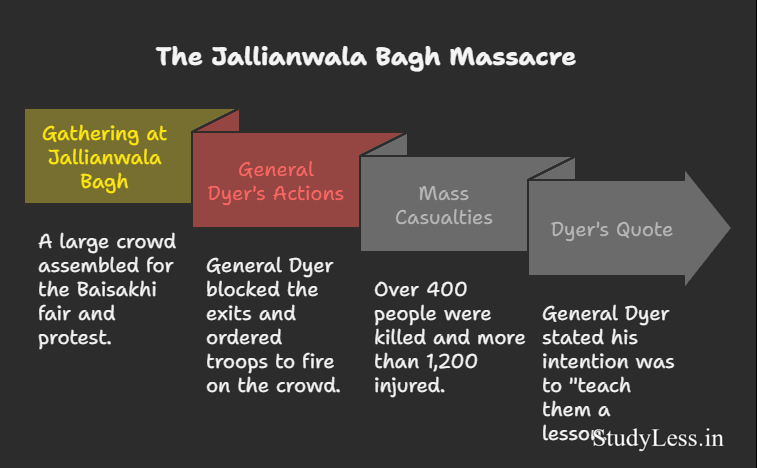
🔥 Aftermath: Anger and Brutal Repression
People across North India erupted in rage:
- Strikes, attacks on police stations, burnt government buildings.
- British responded with humiliating punishments:
- Forced people to crawl on streets.
- Villages bombed in Punjab.
Gandhi’s Dilemma:
He called off the movement because violence broke out. “Means are as important as ends,” he said.
Thought-Provoking Question:
Was Gandhi right to stop the movement? What would YOU have done?
🤝 The Khilafat Connection: Hindus + Muslims Unite!
Gandhi realized the Rowlatt protests were limited to cities. To reach villages, he needed Hindu-Muslim unity.
Enter the Khilafat Issue:
- After WWI, the British planned to weaken the Ottoman Caliph (Muslims’ spiritual leader).
- Muslim leaders like Ali Brothers joined hands with Gandhi.
Gandhi’s Masterstroke:
He merged the Khilafat Movement with the fight for Swaraj (self-rule).
Quote to Ponder:
“Unity is strength… when there is teamwork, wonderful things can be achieved.”
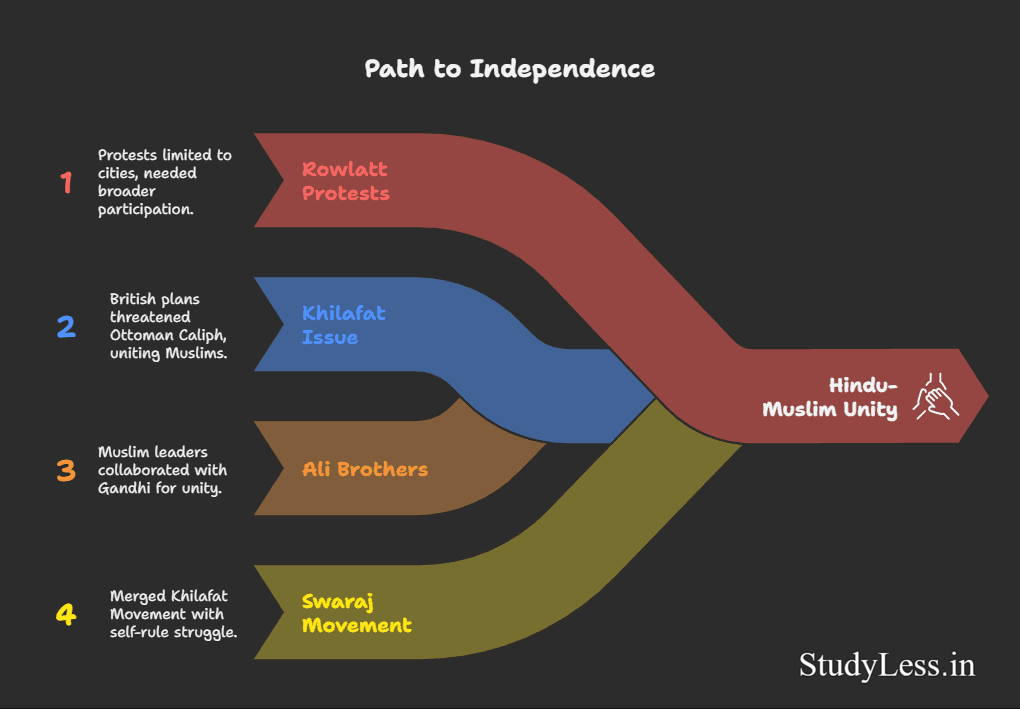
📊 Rowlatt Act vs. Khilafat Movement (Table Time!)
| Aspect | Rowlatt Satyagraha | Khilafat Movement |
|---|---|---|
| Goal | Protest unfair law | Protect Ottoman Caliph |
| Participants | Urban masses | Muslims + Gandhi’s followers |
| Impact | Exposed British cruelty | Boosted Hindu-Muslim unity |
Brain Tickler:
Why did Gandhi link Khilafat with Swaraj? Was it a smart move?
🔍 Quick Check: Rowlatt Act Recap
MCQs (Choose the Truth!):
- The Rowlatt Act allowed the British to:
a) Give Indians sweets
b) Arrest without trial
c) Build schools
Assertion & Reason:
- Assertion: Gandhi called off the Rowlatt Satyagraha.
- Reason: He wanted to start the Khilafat Movement.
Short Questions (1 Line!):
- Why was Jallianwala Bagh a turning point in India’s freedom struggle?
🧩 Rowlatt Act’s Big Lesson: Time to Go Rural!
The Rowlatt Satyagraha shook cities, but villages stayed silent. 😶 Gandhi realized: “Freedom needs farmers, workers, and shopkeepers—not just city folks!” But how?
Problem:
- Hindus and Muslims weren’t fully united.
- Villagers saw the movement as a “city problem.”
Solution:
Gandhi found a secret weapon—the Khilafat Movement! 🤝
🕌 Khilafat Movement: Uniting Hindus & Muslims
What’s the Deal?
After World War I, the British planned to dethrone the Ottoman Caliph (Khalifa), the spiritual leader of Muslims worldwide. Indian Muslims were furious! 😡
Gandhi’s Genius Move:
He linked the Khilafat issue with Swaraj (self-rule). “If we fight together, we win together!”
Key Players:
- Ali Brothers (Muhammad Ali and Shaukat Ali) – Young Muslim leaders.
- Congress Leaders – Initially hesitant, but Gandhi convinced them!
Fun Fact:
The Khilafat Committee was formed in Bombay (March 1919) – the same city where Congress was born! 🌆
📊 Merging Movements: Khilafat + Swaraj (Table Time!)
| Khilafat Movement | Non-Cooperation for Swaraj |
|---|---|
| Protect Ottoman Caliph | End British rule in India |
| Led by Muslim leaders | Led by Gandhi & Congress |
| Religious sentiment + political goal | Nationalist sentiment + political goal |
Brain Tickler:
Was mixing religion with politics a risky move? Why/why not?
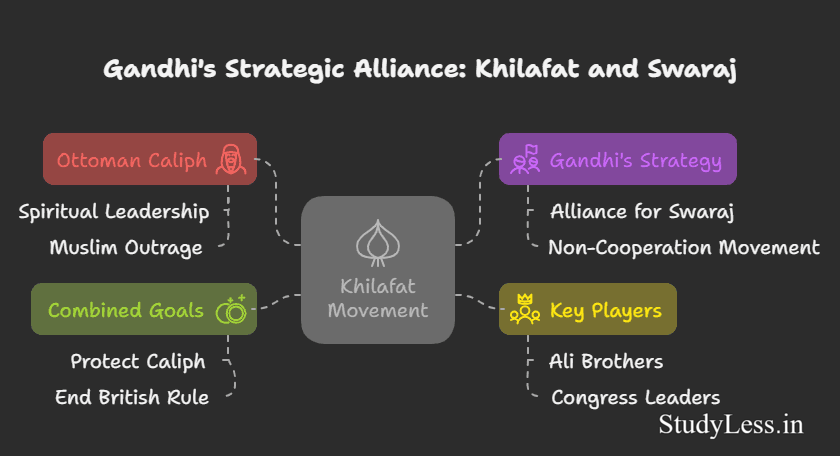
💡 Why Did Gandhi Bet on Khilafat?
- Unity = Strength: Like your class uniting to demand better canteen food, Hindus + Muslims together could pressure the British. 🥘
- Expand the Base: Peasants and villagers cared about religious issues—this could pull them into the freedom struggle.
- Global Angle: Supporting the Caliph made India’s fight part of a global anti-colonial wave. 🌍
Gandhi’s Quote:
“Unity is the one condition of national life.”
🔥 Calcutta Congress (1920): The Non-Cooperation Pact
In September 1920, Gandhi convinced Congress leaders to:
- Launch the Non-Cooperation Movement.
- Support Khilafat and Swaraj together.
Result:
A mega alliance of students, lawyers, farmers, and workers! 👩🎓👨🌾
Relatable Analogy:
It’s like your school’s cricket team, drama club, and science geeks uniting to protest unfair rules! 🏏🎭
🔍 Quick Check: Did You Connect the Dots?
MCQs (Choose the Right Answer!):
- Gandhi linked Khilafat with Swaraj to:
a) Start a food festival
b) Unite Hindus and Muslims
c) Learn Turkish history
Assertion & Reason:
- Assertion: The Khilafat Movement helped Gandhi reach villages.
- Reason: Villagers were deeply religious.
Short Questions (1 Line!):
- Name two leaders of the Khilafat Movement.
🚀 Towards Non-Cooperation?
Now that Hindus and Muslims were united, Gandhi planned his boldest step yet—asking Indians to boycott everything British! 🚫📚
- But why abandon schools, jobs, and titles?
- Could this really push the British out?
Teaser:
Imagine your entire school refusing to attend classes until the principal quits. That’s Non-Cooperation! 😱
Ready to decode Gandhi’s master plan? Let’s jump into Why Non-cooperation? – where unity meets action! 💥
🌟 What’s Next? Why Non-Cooperation?
Gandhi now planned his biggest movement yet—asking Indians to boycott everything British! 🚫🏛️
- But why? How?
- Could students, farmers, and workers unite for this?
Teaser:
Imagine your school declaring a “No Homework Rebellion”—but on a national scale! 📚✨
Ready to dive into Gandhi’s boldest gamble? Let’s explore Why Non-cooperation? next! 💪
🚫 Why Non-Cooperation? Gandhi’s Master Plan
Imagine if your entire class decided to boycott exams until the principal changes unfair rules. That’s what Gandhi wanted for India! He believed British rule survived only because Indians cooperated. Stop cooperating, and the empire crumbles! 💥
Gandhi’s Big Idea from Hind Swaraj (1909):
“British rule is a puzzle held together by our cooperation. Pull out the pieces, and the puzzle falls apart!”
📜 Non-Cooperation in 3 Steps
Gandhi planned it like a video game strategy:
- Level 1:
- Surrender British titles (like “Sir” or “Rai Bahadur”).
- Boycott schools, courts, jobs, and foreign goods.
- Level 2: If the British hit back with violence, launch full civil disobedience (refuse to pay taxes, ignore laws).
- Level 3: Swaraj (self-rule) achieved! 🏆
Fun Analogy:
It’s like unsubscribing from a toxic app—no users, no profit! 📱
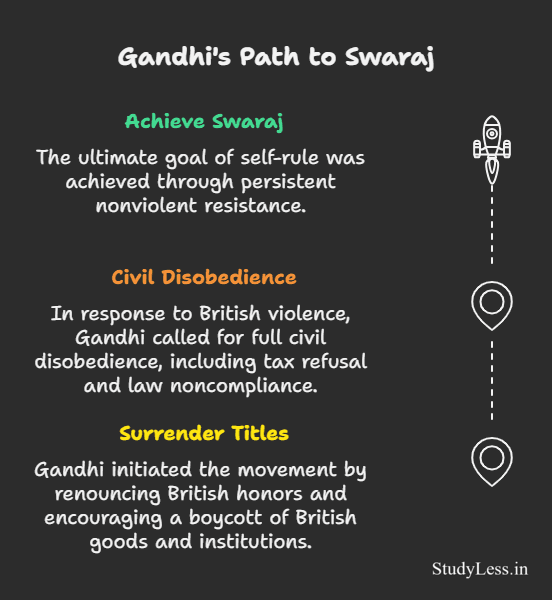
🗣️ Congress Debate: To Boycott or Not?
Even Congress leaders were split!
- Pro-Boycott Team (Gandhi):
“British councils are fake democracy! Boycott them!” - Anti-Boycott Team:
“But what if people turn violent? Let’s contest elections instead!”
The Nagpur Compromise (Dec 1920):
After heated debates (like your group project arguments! 😤), Congress finally agreed to Non-Cooperation.
Thought-Provoking Question:
Would YOU boycott your school council if it was controlled by outsiders?
📊 Non-Cooperation: What to Boycott? (Table Time!)
| Boycott Target | Why? | Impact |
|---|---|---|
| Schools & Colleges | Reject British education | Create Indian schools (like Jamia Millia!) |
| Courts | Build Indian justice systems | Panchayats gained importance |
| Foreign Cloth | Promote Khadi (Swadeshi) | Hurt British economy |
Brain Tickler:
Why did Gandhi focus on foreign cloth? (Hint: It’s symbolic + economic!)
🔍 Quick Check: Are You a Non-Cooperation Pro?
MCQs (Choose the Truth!):
- Gandhi believed British rule depended on:
a) Magic
b) Indian cooperation
c) Good weather
Assertion & Reason:
- Assertion: Some Congress leaders feared Non-Cooperation.
- Reason: They worried it might lead to violence.
Short Questions (1 Line!):
- What was the first step of the Non-Cooperation Movement?
🌟 Real-Life Connect: What Would YOU Do?
Scenario: Your town’s park is taken over by outsiders. Gandhi’s plan would ask you to:
- Boycott the park.
- Build a new one with your community.
- Protest peacefully.
Which step would you start with? 🌳
💥 What’s Next? The Movement Splits!
Non-Cooperation wasn’t a single story—it had different strands! Students, farmers, workers, and tribes joined, but each had their own dreams. Some wanted Swaraj, others wanted lower taxes or respect.
Teaser:
Ever seen friends agree on a pizza topping? Spoiler: It’s harder than you think! 🍕
Ready to explore the drama within the movement? Let’s dive into Differing Strands within the Movement next! 💥
🏙️ Non-Cooperation in Cities: Students, Lawyers & Bonfires!
Imagine your entire class boycotting exams to protest unfair rules. That’s what happened in 1921! Students quit British schools, teachers resigned, and lawyers like Chittaranjan Das gave up their practices. 📚⚖️
Why Madras was Different:
The Justice Party (non-Brahmins) joined council elections to challenge Brahmin dominance. “If you can’t beat them, join them—and change the game!”
Fun Fact:
Jamia Millia Islamia and Kashi Vidyapeeth were born during this boycott! 🎓
💸 Economic Fireworks: Boycott Foreign Goods!
People turned foreign cloth into bonfire parties! 🔥
- Foreign cloth imports dropped from ₹102 crore to ₹57 crore (1921–22).
- Merchants refused to sell British goods.
- Sales of Khadi (Indian cloth) and handlooms soared! 🧵
Gandhi’s Quote:
“Every charkha (spinning wheel) spins the thread of freedom.”
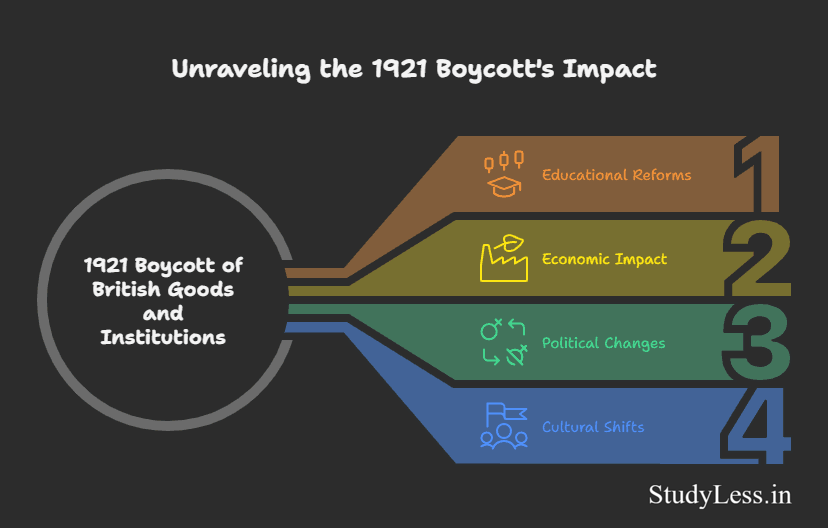
📉 Why Did the Urban Movement Slow Down?
- Khadi = Expensive:
- Poor folks couldn’t afford Khadi (like choosing between ₹500 jeans vs. ₹5000 designer wear!).
- No Alternatives:
- Few Indian schools/colleges were built. Students crept back to British schools. 😔
- Burnout:
- Protests need stamina! People got tired of sacrificing daily needs.
Thought-Provoking Question:
Would YOU boycott smartphones if Indian alternatives were slower and pricier?
📊 City vs. Village Boycott (Mini-Table)
| Aspect | Cities | Villages (Coming Next!) |
|---|---|---|
| Participants | Students, lawyers, teachers | Farmers, tribals |
| Focus | Education, foreign goods | Land rights, taxes |
| Challenges | Costly Khadi, lack of schools | Brutal repression, poverty |
Brain Tickler:
Why did city protests depend on middle-class participation?
🔍 Quick Check: City Movement Recap
MCQs (Choose the Truth!):
- Why did foreign cloth imports drop?
a) Indians forgot shopping
b) Boycott and bonfires
c) British stopped making cloth
Assertion & Reason:
- Assertion: The Justice Party joined council elections.
- Reason: They wanted Brahmin dominance to continue.
Short Questions (1 Line!):
- Name one Indian institution started during Non-Cooperation.
🌟 What’s Next? Villages Rise Up!
Cities slowed down, but villages were just warming up! Farmers and tribals rebelled against landlords and British laws. Imagine your entire neighborhood protesting against sky-high rent! 🌾💥
Teaser:
Why did a tribal leader in Andhra call Non-Cooperation “a fight for our forests and dignity”? Let’s find out!
Ready to explore the rural fire of rebellion? Let’s dive into Rebellion in the Countryside! 🔥
🌾 Rebellion in the Countryside: Peasants & Tribals Join the Fight
When the Non-Cooperation Movement reached villages, it wasn’t just about foreign cloth or schools—it became a battle for survival! Farmers and tribals rebelled against unfair taxes, forced labor, and lost forest rights. Let’s explore two fiery stories!
👨🌾 Awadh Peasants vs. Greedy Landlords
Leader: Baba Ramchandra (a former indentured laborer from Fiji).
Problems:
- High Rent: Imagine paying 80% of your crop as rent!
- Begar: Forced unpaid labor (like doing homework for your bully!).
- No Land Rights: Farmers were evicted anytime.
Solutions:
- Oudh Kisan Sabha (1920): Founded by Jawaharlal Nehru and Ramchandra.
- Social Boycott: Villagers denied landlords even barbers and washermen! ✂️🚫
But Things Got Heated:
Some peasants attacked landlords’ homes, looted markets, and spread rumors: “Gandhi says don’t pay taxes!” 😱
Thought-Provoking Question:
If you were a farmer, would you follow Gandhi’s non-violence or fight back violently?
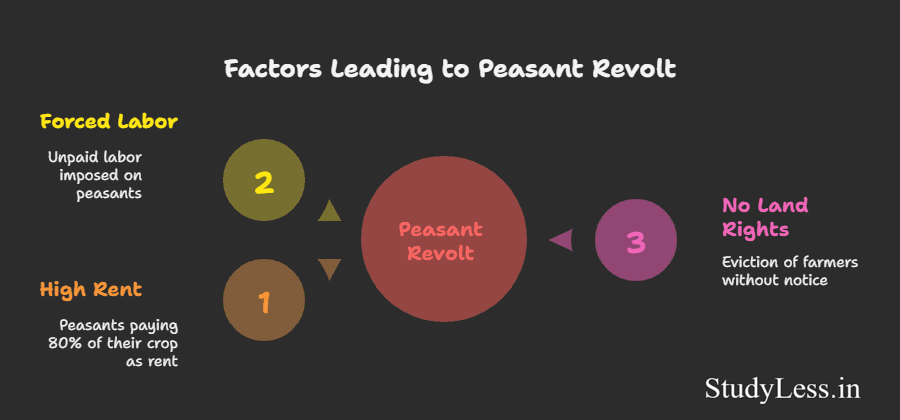
🌳 Gudem Hills (Andhra): Tribal Anger Explodes!
Leader: Alluri Sitaram Raju (a mystic rebel with bulletproof myths! 🔫✨).
Problems:
- Forest Laws: British banned tribal access to forests—no grazing, wood, or fruits!
- Forced Road Labor (Begar): Tribal people said “Enough!”
Raju’s Strategy:
- Mixed Gandhi’s ideas (wear khadi, quit alcohol) with guerrilla warfare.
- Attacked police stations, ambushed officials.
Fun Fact:
Tribals believed Raju was God’s avatar! He was captured and killed in 1924, becoming a legend. 🕊️
Quote to Ponder:
“Swaraj is my birthright!” – Bal Gangadhar Tilak
Did Raju’s violent methods align with Tilak’s slogan?
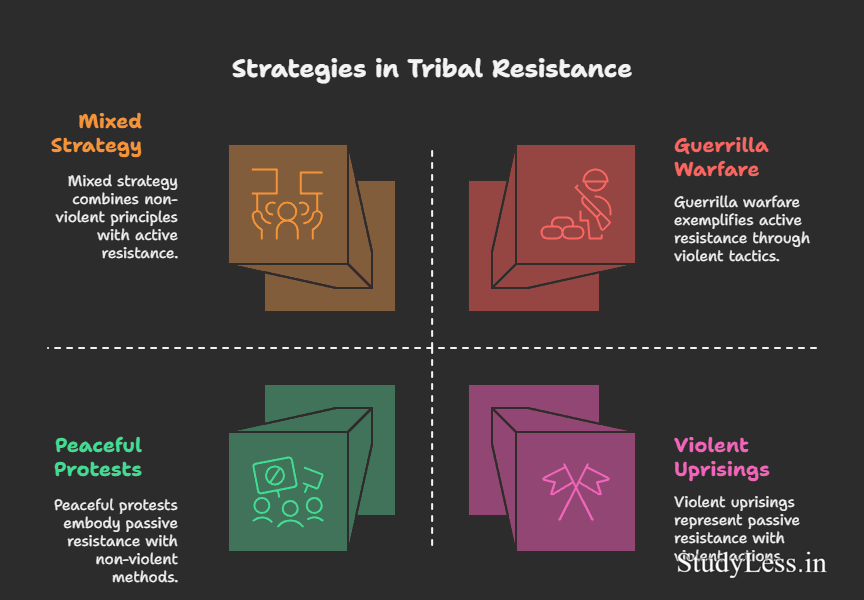
📊 City vs. Village Movements (Table Time!)
| Aspect | Awadh Peasants | Gudem Tribals |
|---|---|---|
| Leader | Baba Ramchandra | Alluri Sitaram Raju |
| Main Issue | High rent, forced labor | Forest rights, begar |
| Methods | Social boycott, protests | Guerrilla attacks, violence |
| Congress Reaction | Unhappy (too violent) | Disapproved (non-violence breach) |
Brain Tickler:
Why did Gandhi’s name inspire both peaceful and violent protests?
🔍 Quick Check: Rural Rebellion Recap
MCQs (Choose the Truth!):
- What was begar?
a) A type of dance
b) Forced unpaid labor
c) A festival
Assertion & Reason:
- Assertion: The Congress disapproved of the Awadh peasant methods.
- Reason: They believed only non-violence could achieve Swaraj.
Short Questions (1 Line!):
- Name one demand of the Awadh peasants.
🌟 Real-Life Connect: Your Turn!
Scenario: Your school bans you from the playground. Would you:
a) Peacefully protest?
b) Start a petition?
c) Sneak in at night?
Tribals chose (c) when forests were banned! 🌲
🚜 What’s Next? Swaraj in the Plantations!
While peasants fought landlords, plantation workers in Assam dreamt of Swaraj too! For them, freedom meant escaping brutal laws and returning home.
Teaser:
Imagine being trapped in a tea garden, miles from home. How would YOU break free? ☕🏃
Ready to explore the untold stories of plantation workers? Let’s uncover Swaraj in the Plantations next! 🌱
🌱 Swaraj in the Plantations: The Dream of Freedom
Imagine being trapped in your school hostel forever, forbidden to visit home. That’s how plantation workers in Assam felt under British rule! For them, Swaraj meant breaking free from the tea gardens and returning to their villages. Let’s dive into their struggle!
⛓️ Life in Plantations: A Cage Called “Law”
Under the Inland Emigration Act (1859):
- Workers were legally trapped in tea estates.
- Needed permission to leave—rarely granted!
- Lived in brutal conditions with low wages.
Fun Fact:
Tea plantation workers were often tricked into contracts with false promises of good pay. ☕😠
🚶♂️ Non-Cooperation Hits the Plantations
When workers heard of Gandhi’s movement (1921), they:
- Defied the British, left plantations en masse.
- Marched home, believing “Gandhi Raj” would give them land.
But Disaster Struck:
- Railway/steamer workers were on strike—stranded them mid-journey.
- Police brutally beat and arrested them. Many never made it home. 😢
Quote to Ponder:
“Freedom is never given; it is won.” – A. Philip Randolph
Did the plantation workers “win” freedom here?
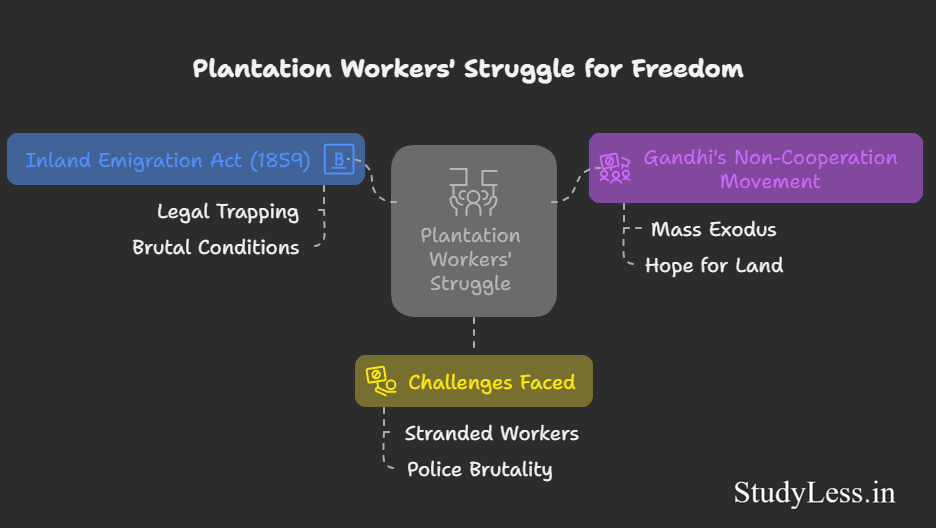
📊 Workers’ Swaraj vs. Congress’ Swaraj (Table Time!)
| Aspect | Plantation Workers’ Swaraj | Congress’ Swaraj |
|---|---|---|
| Meaning | Right to move, return to villages | Political independence from British |
| Action | Mass exodus from plantations | Non-violent protests, boycotts |
| Outcome | Brutal suppression | Unified national movement |
Brain Tickler:
Why did workers link their struggle to Gandhi, even though he didn’t organize them?
🔍 Quick Check: Plantation Workers’ Plight
MCQs (Choose the Truth!):
- The Inland Emigration Act:
a) Allowed free movement
b) Trapped workers in plantations
c) Gave workers holidays
Assertion & Reason:
- Assertion: Plantation workers believed Swaraj meant returning home.
- Reason: They were inspired by Gandhi’s call for Non-Cooperation.
Short Questions (1 Line!):
- What stopped plantation workers from reaching their villages?
💔 Why This Story Matters
The workers’ revolt shows how Nationalism in India meant different things to different people. For some, it was political freedom; for others, it was survival and dignity.
Thought-Provoking Question:
Can a freedom movement succeed without addressing the poorest people’s needs?
🌟 What’s Next? Towards Civil Disobedience
Gandhi realized Non-Cooperation wasn’t enough. He needed a bigger weapon—Civil Disobedience (breaking unfair laws openly!). But how? From breaking salt laws to facing lathis, let’s explore Gandhi’s boldest challenge to the British! 💥
Teaser:
Imagine your entire town refusing to pay taxes. That’s Civil Disobedience! Will the British back down?
Ready to defy the salt law? Let’s march into Towards Civil Disobedience next! 🧂✨
🛑 Why Did Gandhi Press Pause on Non-Cooperation?
Imagine your coach stopping a game because the team starts fouling. That’s what Gandhi did in 1922! He withdrew the Non-Cooperation Movement because:
- Violence erupted (like the Chauri Chaura incident).
- He felt Indians needed more training in non-violence.
Congress Split:
- Team Swaraj Party (C.R. Das, Motilal Nehru): “Let’s join councils and fight from within!” 🗳️
- Team Radicals (Jawaharlal Nehru, Subhas Bose): “Forget councils—demand full independence now!” 💥
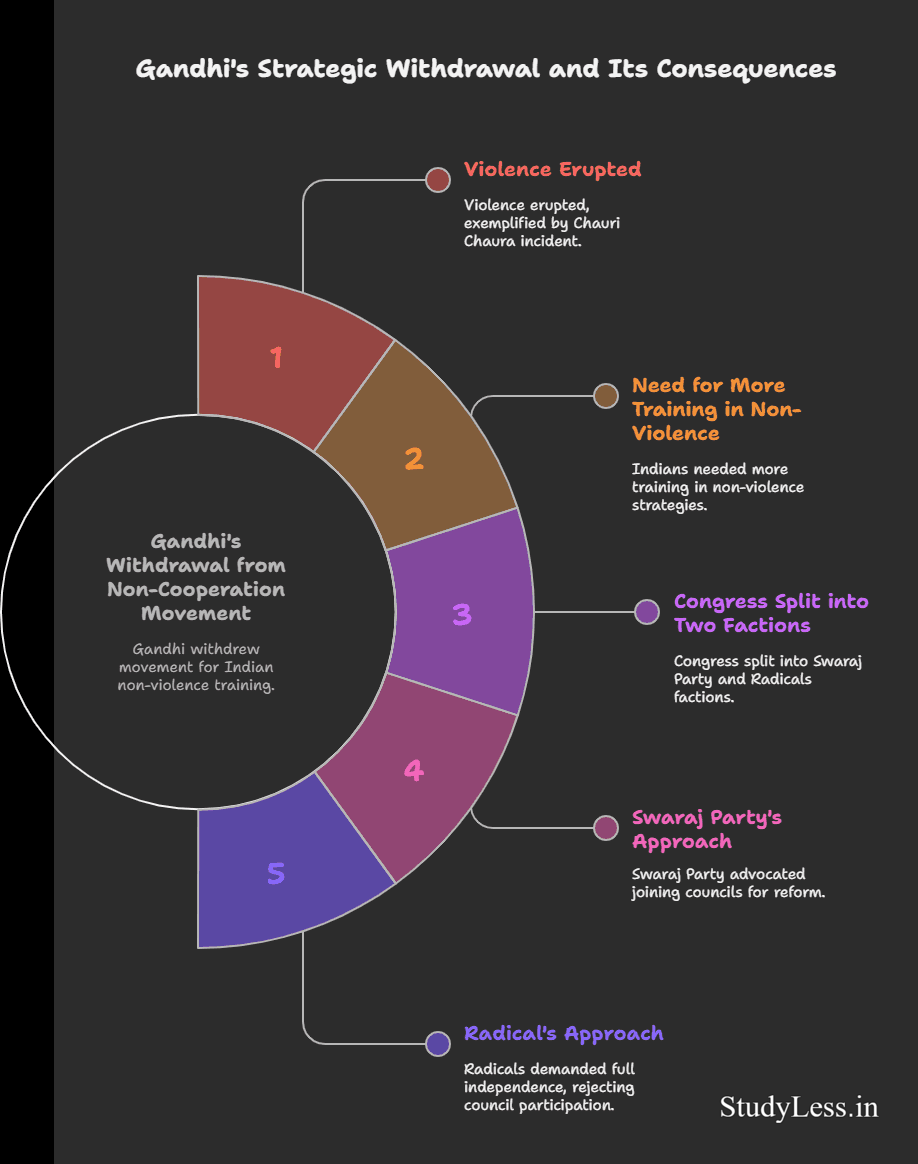
Thought-Provoking Question:
If you were in Congress, would you focus on reforms or revolution?
📉 1929 Economic Depression: Farmers in Crisis!
The Great Depression wasn’t just a Western problem! 💔
- Farmers’ Woes: Prices of crops like wheat and cotton crashed.
- Result: Farmers couldn’t sell harvests or pay taxes. Rural India was boiling!
Relatable Analogy:
It’s like your mom selling homemade pickles, but suddenly no one buys them—and the rent is due! 🥒
👨⚖️ Simon Commission: Why “Go Back Simon” Trended
In 1928, Britain sent the Simon Commission (all British members!) to “fix” India’s laws. Indians roasted it with “Go Back Simon!” slogans.
Why the Anger?
- Zero Indian Members: Like a school committee making rules without students! 😤
- Congress + Muslim League Unity: Rare moment of teamwork against a common enemy.
Fun Fact:
Young leaders like Jawaharlal Nehru and Bhagat Singh led protests. 🇮🇳
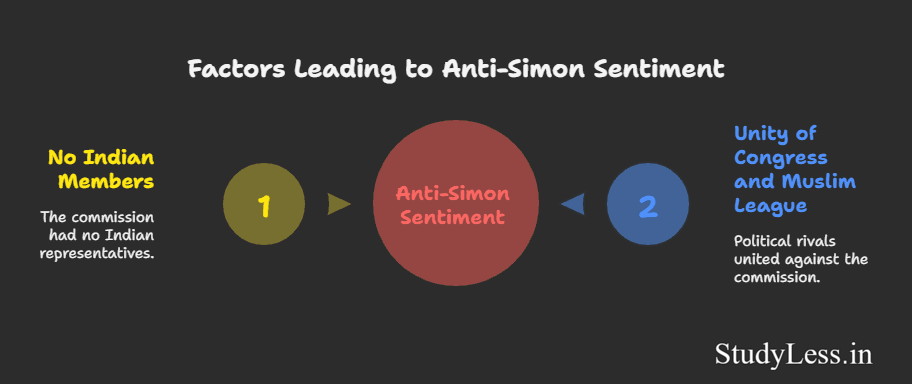
🕊️ 1929: The Demand for Purna Swaraj (Total Freedom)
Tired of British half-promises, Congress declared 26 January 1930 as Independence Day at the Lahore Session. But…
Problem:
Most Indians didn’t connect with this “abstract” idea. Gandhi needed a symbolic issue everyone understood—like salt! 🧂
Quote to Ponder:
“Freedom is not worth having if it does not include the freedom to make mistakes.” – Gandhi
📊 Congress Factions: Swaraj Party vs. Radicals (Table Time!)
| Group | Leaders | Goal | Strategy |
|---|---|---|---|
| Swaraj Party | C.R. Das, Motilal Nehru | Reforms within British system | Contest council elections |
| Radicals | J. Nehru, Subhas Bose | Full independence (Purna Swaraj) | Mass protests, strikes |
Brain Tickler:
Why did the Simon Commission backfire for the British?
🔍 Quick Check: Did You Catch the Clues?
MCQs (Pick the Right Answer!):
- Why did Gandhi stop Non-Cooperation?
a) He got bored
b) Violence broke out
c) British bribed him
Assertion & Reason:
- Assertion: The Simon Commission was rejected by Indians.
- Reason: It included Indian leaders.
Short Questions (1 Line!):
- What was declared on 26 January 1930?
🌟 What’s Next? Salt March: Gandhi’s Masterstroke!
Gandhi needed a simple, powerful issue to unite Indians. He chose… SALT! 🧂💪 From taxing a basic need to marching 240 miles, let’s explore how Civil Disobedience became a people’s revolution!
Teaser:
What’s common between your kitchen salt and India’s freedom? Find out in the next chapter! 🔥
Ready to walk with Gandhi? Let’s stride into The Salt March and Civil Disobedience Movement! 👣✨
🧂 The Salt March: Gandhi’s Masterstroke!
Imagine your school principal taxing lunchboxes—that’s how unfair the salt tax was! Gandhi chose salt as a symbol because everyone used it—rich or poor. 🧂💡
Gandhi’s Ultimatum to the British (1930):
- Sent Viceroy Irwin 11 demands, including abolishing the salt tax.
- Warned: “Accept by 11 March, or face civil disobedience!”
- Irwin ignored it. So, Gandhi marched!
Fun Fact:
The 240-mile Salt March was like walking from Delhi to Jaipur—24 days, 10 miles/day! 🚶♂️✨
⏳ The March Begins: Sabarmati to Dandi
12 March 1930: Gandhi + 78 volunteers started their journey.
- Thousands joined, chanting “Swaraj!” along the way.
- 6 April 1930: Reached Dandi, made salt from seawater—defying the law!
Quote to Ponder:
“With this pinch of salt, I shake the British Empire!” – Gandhi
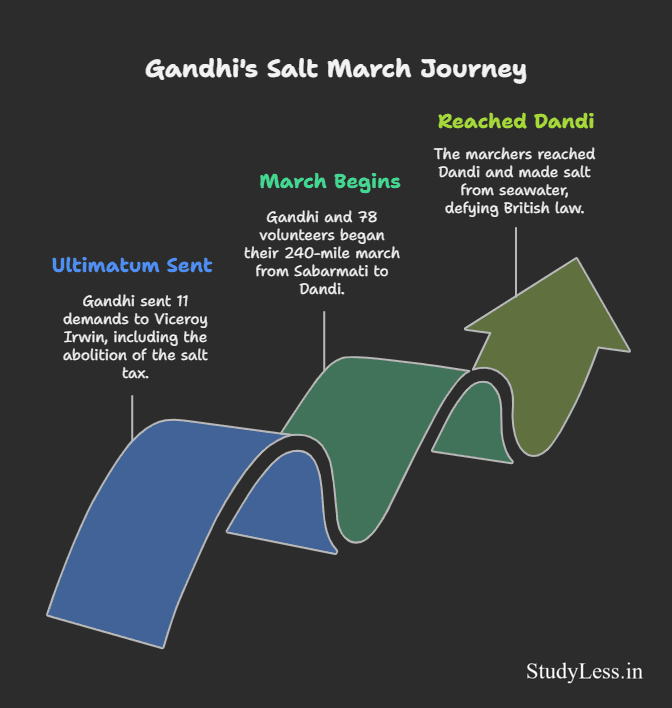
💥 Civil Disobedience Movement Begins!
How was this different from Non-Cooperation?
- Non-Cooperation (1920s): Boycott schools, courts, goods.
- Civil Disobedience (1930s): Break colonial laws openly!
Examples of Disobedience:
- Villagers made salt, ignored forest laws.
- Peasants refused taxes, workers picketed liquor shops.
- Students burnt foreign clothes.
Relatable Analogy:
It’s like your entire town ignoring a “No TikTok” ban and dancing anyway! 💃🕺
📊 Non-Cooperation vs. Civil Disobedience (Table Time!)
| Aspect | Non-Cooperation (1920) | Civil Disobedience (1930) |
|---|---|---|
| Goal | Withdraw cooperation | Break unjust laws |
| Key Symbol | Khadi cloth | Salt |
| Govt Response | Arrests, violence | Brutal repression, mass arrests |
Brain Tickler:
Why was breaking laws more powerful than just boycotting?
🔥 British Crackdown: Violence vs. Non-Violence
The British panicked and arrested leaders like Gandhi, Nehru, and Abdul Ghaffar Khan (Frontier Gandhi).
- Peshawar Protest (1930): Police fired on unarmed crowds.
- Sholapur Uprising: Workers attacked symbols of British rule (courts, trains).
Gandhi’s Dilemma:
He called off the movement in 1931 after the Gandhi-Irwin Pact to attend the Round Table Conference in London. But the British broke promises, leading to Round 2 of protests in 1932!
Thought-Provoking Question:
Was stopping the movement a mistake, or did it save lives?
📉 Why Did the Movement Lose Steam?
By 1934, the movement faded because:
- Brutal Repression: 100,000+ arrested, protests crushed.
- Fatigue: People were exhausted.
- Limited Reach: Poor peasants/workers felt sidelined.
Fun Fact:
The Dandi March inspired global movements, like the US Civil Rights Struggle! 🌍✊
🔍 Quick Check: Salt March Recap
MCQs (Choose Wisely!):
- Gandhi’s Salt March started from:
a) Delhi
b) Sabarmati Ashram
c) Mumbai
Assertion & Reason:
- Assertion: The Salt March targeted the British economy.
- Reason: Salt was a daily necessity taxed heavily by the British.
Short Questions (1 Line!):
- Why did Gandhi choose salt as a symbol of protest?
🌟 What’s Next? Differing Views of Participants
The Civil Disobedience Movement wasn’t one story—it was thousands!
- Farmers saw it as a fight against taxes.
- Workers wanted better wages.
- Women saw it as a chance to step into leadership.
Teaser:
Did a rich industrialist and a tribal farmer want the same Swaraj? Let’s find out! 👀
Ready to explore diverse voices in the freedom struggle? Let’s dive into How Participants Saw the Movement! 🗣️🌍
🌾 Rich Peasants: The Cash Crop Crusaders
Who? Patidars (Gujarat) + Jats (UP) – wealthy farmers growing cotton, wheat.
Why Angry?
- Great Depression (1930s): Crop prices CRASHED! 💸
- Example: Imagine selling a sack of wheat for ₹100 → now ₹30!
- High Revenue Demand: British kept taxes high despite their losses.
Role in Movement:
- Organized protests, forced others to join boycotts.
- Dream: Swaraj = Lower taxes + Profit!
But…
When Gandhi paused the movement in 1931 (Gandhi-Irwin Pact) without tax cuts, they felt betrayed and quit in 1932.
Fun Fact:
Rich peasants were like the “VIP members” of the movement – powerful but quick to exit when benefits stopped! 🎫
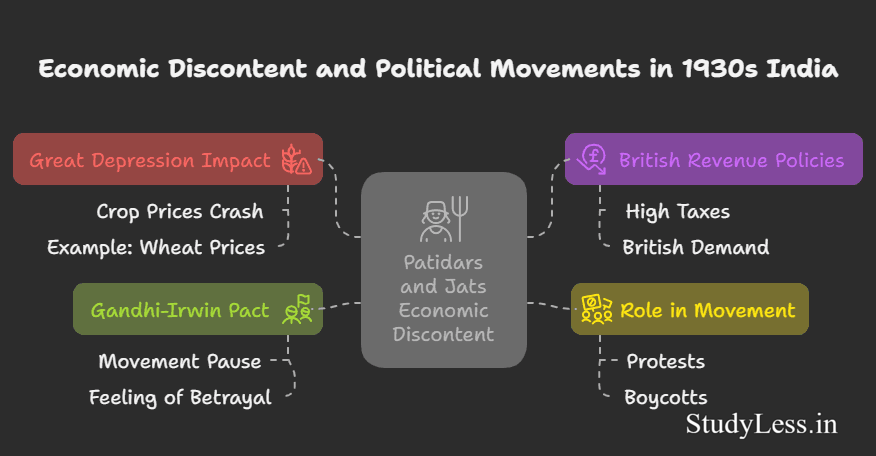
🧑🌾 Poor Peasants: The Rent Rebels
Who? Small farmers renting land from zamindars.
Struggle:
- Double Whammy: Low crop prices + High rent.
- Example: Earn ₹500/month → Rent = ₹600! 😱
- Demand: “Cancel our unpaid rent!”
Role in Movement:
- Joined radical groups (Socialists/Communists) for “no rent” campaigns.
- Dream: Swaraj = Own land + No debt!
Congress’s Dilemma:
- Avoided supporting “no rent” to keep rich peasants + landlords happy.
- Poor peasants felt ignored – relationship with Congress = ❓
Thought-Provoking Question:
Should the Congress have prioritized poor peasants over unity?
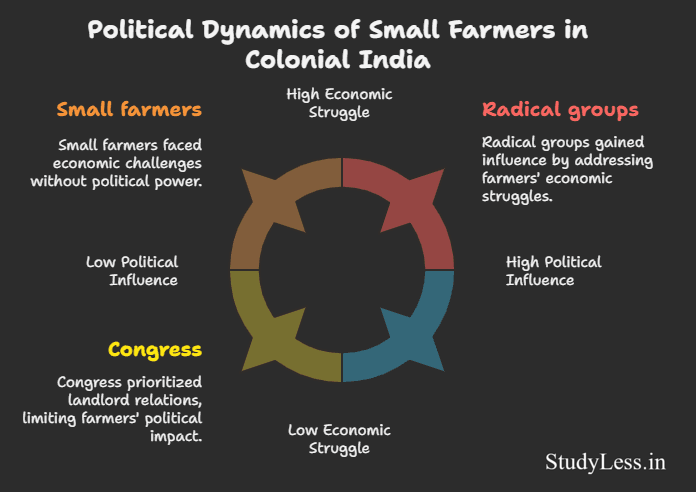
📊 Rich vs. Poor Peasants: A Quick Compare
| Aspect | Rich Peasants | Poor Peasants |
|---|---|---|
| Main Issue | High revenue taxes | Unaffordable rent + debt |
| Allies | Congress | Socialists/Communists |
| Swaraj Meaning | Lower taxes | Land ownership + rent freedom |
| Congress Support | Full backing | Reluctant/ignored |
Brain Tickler:
Why couldn’t Gandhi unite both groups?
🔍 Quick Quiz: Test Your Knowledge!
MCQs:
- Rich peasants withdrew support in 1932 because:
a) They hated Gandhi
b) No tax cuts after 1931 pause
c) They loved British rule
Assertion & Reason:
- Assertion: Poor peasants joined Socialist groups.
- Reason: Congress supported their ‘no rent’ demands.
Short Answer (1 Line):
- What did poor peasants want besides lower revenue?
💡 Why This Matters for Nationalism in India
The Civil Disobedience Movement wasn’t just a fight against the British – it was a class conflict!
- Rich vs. Poor: Different needs, same enemy.
- Congress’s Challenge: Balancing unity vs. addressing inequalities.
Real-Life Analogy:
Imagine a school protest where rich kids want cheaper uniforms, while poor kids demand free meals. Can the principal please everyone? 🍱👔
🌟 What’s Next? Businessmen, Workers & More!
Spoiler: Factory workers, industrialists, and women had their own versions of Swaraj! Stay tuned to see how a millionaire and a mill worker clashed over freedom! 💼🏭
💼 Business Classes: Profit Meets Patriotism
Imagine your local shopkeeper joining a protest to ban foreign products – that’s what Indian industrialists did during the Civil Disobedience Movement! Let’s decode their role:
🏭 Why Did Businessmen Support the Movement?
- Post-WWI Ambitions:
- After making big profits during WWI, industrialists wanted to expand but were blocked by British policies.
- Example: High tariffs on Indian goods, unfair forex rates (rupee vs. sterling) hurt exports.
- Demands:
- Protection from British Imports: “Make in India” before it was cool! 🏗️
- Economic Freedom: Swaraj = No colonial restrictions on business!
- Key Actions:
- Formed FICCI (1927) to lobby for Indian industries.
- Funded Congress, boycotted foreign goods.
- Leaders like G.D. Birla (yes, the Birla Group founder!) openly backed Gandhi.
📉 But Why Did Their Support Fade?
After the Round Table Conference (1931) failed:
- Fear of Chaos: Worried about militant protests disrupting trade.
- Socialist Scare: Young Congress leaders talking about workers’ rights scared capitalists.
- Profit vs. Patriotism: Swaraj was good, but “what if it hurts our business?” 💸
Fun Analogy:
It’s like investing in a school fundraiser but backing out when students demand cheaper canteen prices – risky for profits! 🥪
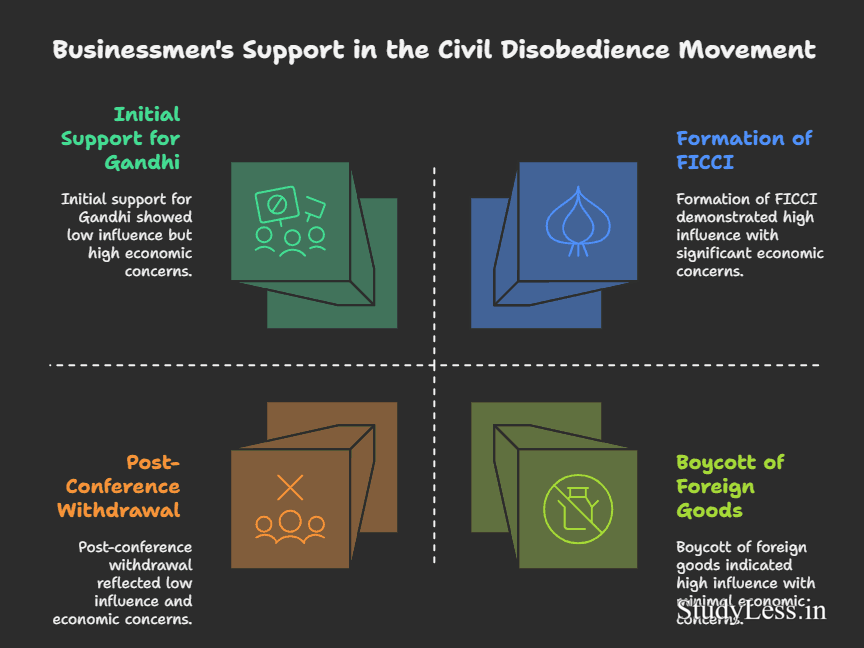
📊 Business Class Participation: A Snapshot
| Phase | Support Level | Reason |
|---|---|---|
| 1930 (Movement Start) | 🔥 High | Hoped for economic freedom |
| Post-1931 | ❄️ Low | Fear of socialism + business disruption |
Did You Know?
G.D. Birla even funded Gandhi’s ashrams! 🧘♂️💵
💡 Thought-Provoking Question:
Can a freedom movement succeed if business elites and the poor want different things?
🔍 Quick Check: Business Class 101
MCQs:
- FICCI was formed to:
a) Promote British goods
b) Lobby for Indian industries
c) Sell khadi
Assertion & Reason:
- Assertion: Businessmen feared socialist ideas in Congress.
- Reason: Socialists supported workers’ rights over industrialists’ profits.
Short Answer (1 Line):
- Name one industrialist who supported Gandhi.
🌟 What’s Next? Workers Enter the Stage!
While businessmen wavered, factory workers joined the movement with their own demands – higher wages, better conditions! But would Gandhi’s non-violence appeal to their fiery strikes?
Teaser:
Imagine your school’s support staff protesting for fair pay. That’s the industrial workers’ Swaraj! 🔥
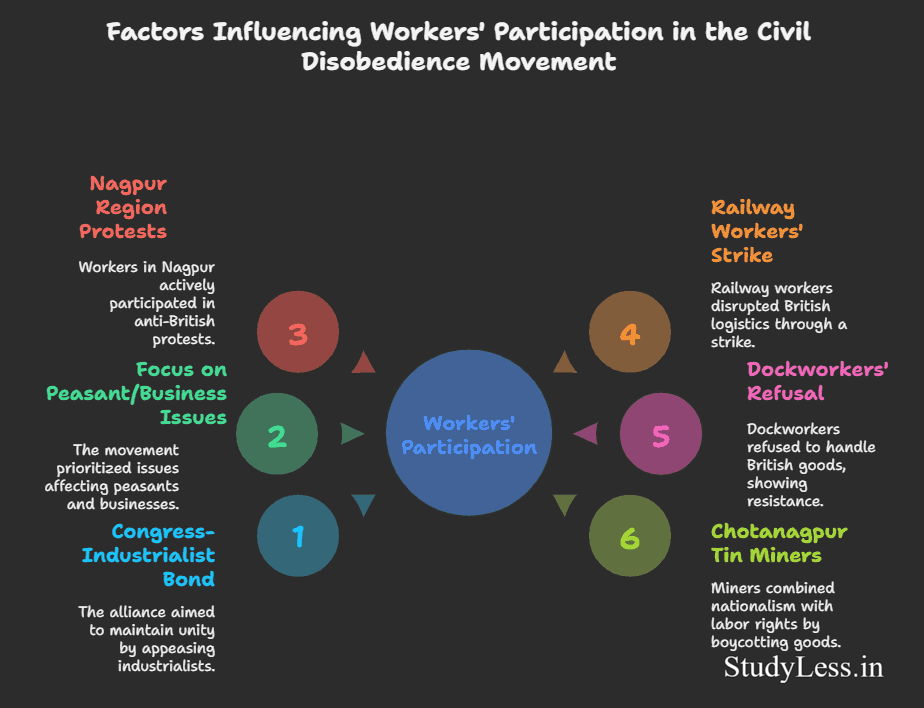
Ready to explore the worker’s side of the story? Let’s dive into The Industrial Working Classes! 🏭👷
🏭 Industrial Workers: Limited but Fiery Participation
While the Civil Disobedience Movement was largely driven by peasants and business classes, industrial workers joined selectively, blending Gandhi’s ideas with their own struggles. Here’s the lowdown:
🚂 Why Workers Stayed Aloof (Mostly)
- Congress-Industrialist Bond: Congress prioritized keeping factory owners happy, fearing worker demands would split the anti-British unity.
- Focus on Peasants/Businesses: Workers’ issues like low wages weren’t part of the main agenda.
But Exceptions Existed!
- Nagpur Region: Workers actively joined protests.
- Railway Workers (1930): Went on strike, disrupting British logistics.
- Dockworkers (1932): Refused to load/unload British goods.
- Chotanagpur Tin Miners: Wore Gandhi caps, joined rallies, boycotted foreign goods – mixing nationalism with labor rights!
📊 Workers vs. Congress: A Clash of Priorities
| Workers’ Demands | Congress’s Stance |
|---|---|
| Higher wages, better conditions | Avoided to keep industrialists happy |
| Inclusion in movement | Feared dividing anti-British forces |
| Adopted boycott of foreign goods | Supported but ignored labor issues |
Fun Fact:
Workers used Gandhi’s boycott tactic but added their own twist – strikes for fair pay! 💪🔨
💡 Thought-Provoking Question:
Could Gandhi have balanced worker rights and industrialist support? Or was ignoring workers a strategic move?
🔍 Quick Check: Workers’ Role
MCQs:
- Chotanagpur miners protested by:
a) Singing songs
b) Wearing Gandhi caps
c) Building statues
Assertion & Reason:
- Assertion: Congress avoided workers’ demands.
- Reason: They wanted to maintain unity with industrialists.
Short Answer (1 Line):
- Name one group of workers who struck during the movement.
🌟 Next Up: Women Ignite the Movement!
While workers struggled for visibility, women stepped into the spotlight – leading marches, making salt, and defying gender norms! How did Swaraj transform their lives? Let’s find out! 💃✨
Teaser:
Imagine your grandma leading a protest against the British. That’s the power of women in Civil Disobedience! 🔥
Ready to meet the unsung heroines? Let’s explore Women in the Civil Disobedience Movement! 🧕🌺
🌸 Women in the Civil Disobedience Movement: Breaking Barriers, But Not Chains
Gandhi’s call for Swaraj ignited a spark in thousands of women, who stepped out of their homes to join the fight! Here’s how they contributed:
🧕 Roles Women Played:
- Urban Women (High-Caste):
- Joined protest marches, made salt, picketed foreign cloth/liquor shops.
- Example: Sarojini Naidu led the Dharasana Salt Works raid after Gandhi’s arrest.
- Rural Women (Rich Peasant Families):
- Mobilized villages, spread Gandhi’s message, and boycotted British goods.
- Jail Time: Many women were arrested, breaking societal norms of the time.
Quote to Ponder:
“When women stand up, the walls of oppression tremble.”
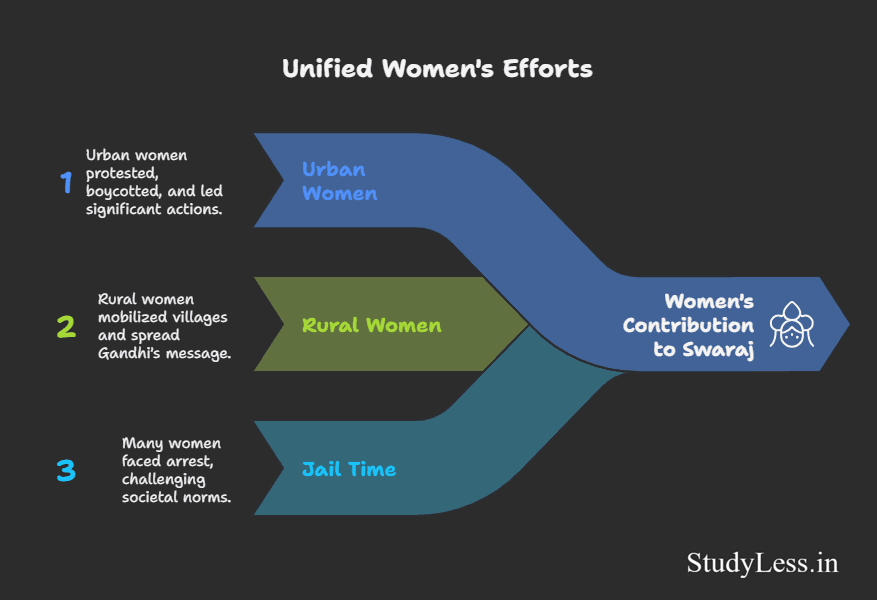
🚺 Paradox of Participation: Freedom Fighters vs. Household Roles
While women shined in the movement, their empowerment hit a glass ceiling:
- Gandhi’s View: “Women’s primary duty is home and family.” 🏡
- Congress’s Stance: Limited women to symbolic roles (e.g., flag-hoisting), denied leadership positions.
- Result: No radical change in gender equality post-movement.
Relatable Analogy:
It’s like letting someone join a soccer team but never letting them score a goal! ⚽
📊 Women’s Participation vs. Recognition (Table Time!)
| Contribution | Limitations |
|---|---|
| Salt-making, picketing | Seen as “helpers”, not leaders |
| Filled jails with courage | No seats in Congress leadership |
| Inspired future generations | Society still saw them as “homemakers” |
Brain Tickler:
Could India’s freedom struggle have succeeded without women?
🔍 Quick Check: Women’s Role Recap
MCQs:
- Sarojini Naidu is known for:
a) Cooking salt
b) Leading the Dharasana raid
c) Designing flags
Assertion & Reason:
- Assertion: Women’s participation didn’t change their societal status.
- Reason: Gandhi and Congress confined them to traditional roles.
Short Answer (1 Line):
- Name one activity rural women did during the movement.
🌟 What’s Next? The Limits of Civil Disobedience
Despite its massive scale, the movement had blind spots. Why did Dalits, Muslims, and some workers stay distant? How did British repression and internal divisions weaken it? Let’s uncover the gaps!
⚖️ The Limits of Civil Disobedience
1. Limited Dalit Participation:
- Dalits (like B.R. Ambedkar) felt ignored by Congress’s focus on caste-Hindu interests.
- Demanded separate electorates, which Gandhi opposed (1932 Poona Pact compromise).
2. Muslim Alienation:
- Khilafat unity faded; Muslims feared Hindu dominance post-independence.
- Example: Jinnah and the Muslim League grew distant.
3. Business Class Withdrawal:
- Industrialists (e.g., Birla) backed out fearing socialism and disruption.
4. Repression & Fatigue:
- British arrested 100,000+ people, imposed martial law.
- By 1934, people were exhausted.
5. Congress’s Selective Approach:
- Ignored poor peasants’ “no rent” demands and workers’ rights to please elites.
Fun Fact:
The Poona Pact (1932) reserved seats for Dalits but denied separate electorates – a bittersweet victory!
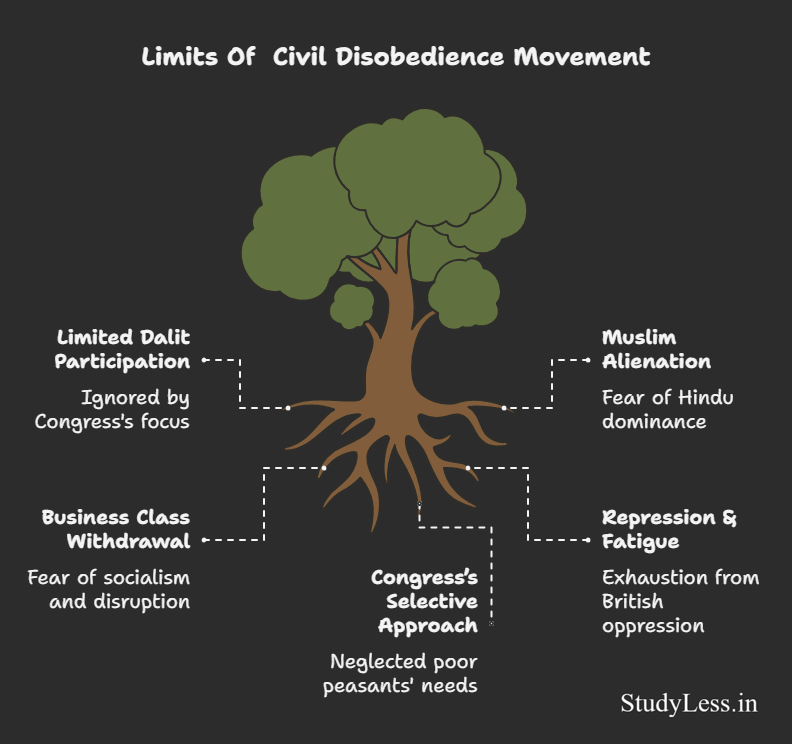
📉 Why Did the Movement Lose Steam?
- No Unity: Different groups wanted different Swaraj.
- British Might: Brutal laws, arrests, and divide-and-rule tactics.
- Congress’s Compromises: Prioritized unity over radical reforms.
Thought-Provoking Question:
Was the Civil Disobedience Movement a “success” despite its limits?
📊 Success vs. Limits (Table Time!)
| Strengths | Weaknesses |
|---|---|
| Unified millions against British | Alienated Dalits, Muslims |
| Global attention to colonialism | Ignored workers’/peasants’ needs |
| Proved mass mobilization power | Repression crushed momentum |
🔍 Quick Check: Limits Recap
MCQs:
- The Poona Pact addressed issues of:
a) Women’s rights
b) Dalit representation
c) Foreign trade
Assertion & Reason:
- Assertion: Muslims grew distant from Congress.
- Reason: They feared Hindu dominance post-independence.
Short Answer (1 Line):
- Name one group that felt excluded from the movement.
🌟 Final Takeaway
The Civil Disobedience Movement was a milestone in India’s freedom struggle but also revealed deep fractures. True Swaraj needed more than unity against the British – it required bridging caste, class, and religious divides.
Food for Thought:
Can a nation be free if some of its people still feel chained? 🤔
🌟 The Limits of Civil Disobedience: Why Not Everyone Joined
The Civil Disobedience Movement united millions, but some groups stayed distant. Let’s explore why Dalits and Muslims hesitated – and how this shaped Nationalism in India.
🚫 Dalits: Fighting Caste, Seeking Justice
Gandhi’s Efforts:
- Called Dalits Harijans (Children of God) and fought for their right to enter temples, use wells, and access schools. 🛐
- Launched campaigns like cleaning toilets to challenge caste stigma.
But Dalit Leaders Wanted More:
- Dr. B.R. Ambedkar demanded separate electorates (Dalits voting for Dalit leaders) for political empowerment.
- Clash with Gandhi: At the 1931 Round Table Conference, Ambedkar argued for separate electorates; Gandhi fasted in protest, fearing it would divide Hindus.
The Compromise – Poona Pact (1932):
- Dalits got reserved seats in legislatures but no separate electorates.
- Mixed Result: Dalits gained representation but remained wary of Congress’s caste-Hindu dominance.
Fun Fact:
Ambedkar later drafted India’s Constitution! 📜
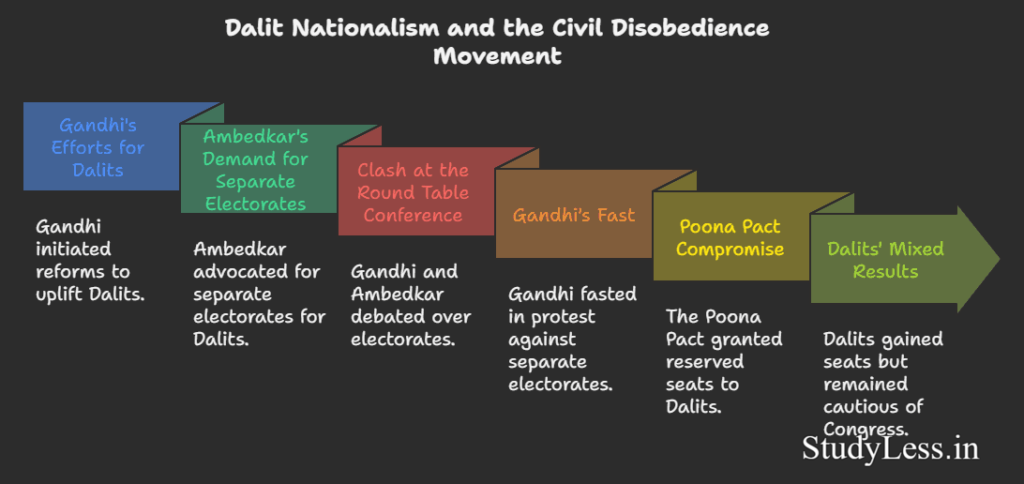
📊 Gandhi vs. Ambedkar: Two Visions for Dalits
| Gandhi’s Approach | Ambedkar’s Demand |
|---|---|
| Social reform + integration | Political power through separate electorates |
| Symbolic gestures (e.g., temple entry) | Legal rights + representation |
| Fear of dividing Hindu unity | Focus on Dalit self-determination |
Thought-Provoking Question:
Was Gandhi’s focus on social reform enough, or did Dalits need political power first?
☪️ Muslims: Growing Distrust
Why the Distance?
- Post-Khilafat Alienation: After 1922, Muslims felt sidelined by Congress.
- Rise of Hindu Mahasabha: Congress’s ties with Hindu nationalist groups scared Muslims.
- Communal Riots: Clashes over religious processions (e.g., music near mosques) deepened divides.
Failed Unity Attempts (1927):
- Jinnah’s Offer: Muslims would give up separate electorates if granted reserved seats in legislatures.
- Congress’s Mistake: Hindu Mahasabha leaders rejected compromise, killing hopes of unity.
Result: By 1930, Muslims saw Civil Disobedience as a “Hindu movement” and stayed away.
Relatable Analogy:
It’s like group projects where some members feel ignored – they stop contributing! 😤

📉 Congress vs. Muslim League Demands
| Congress Stance | Muslim League Demands |
|---|---|
| Unified struggle for Swaraj | Reserved seats + political safeguards |
| Closer to Hindu groups | Fear of Hindu dominance |
| Ignored Muslim anxieties | Wanted proportional representation |
Brain Tickler:
Could India’s partition have been avoided if Congress addressed Muslim concerns earlier?
🔍 Quick Check: Limits Recap
MCQs:
- The Poona Pact focused on:
a) Women’s rights
b) Dalit representation
c) Foreign trade
Assertion & Reason:
- Assertion: Muslims avoided the Civil Disobedience Movement.
- Reason: They feared Hindu dominance post-independence.
Short Answer (1 Line):
- Name one leader who represented Dalit demands.
🌟 The Sense of Collective Belonging
How did Nationalism in India finally unite people across castes, religions, and regions? Discover the power of symbols, songs, and shared pride that stitched a diverse nation together!
Teaser:
Ever wondered how a song or a flag can make strangers feel like family? Let’s unravel the magic! 🎶
🧩 How Did India Feel Like One Nation?
Imagine your school uniting for a football match against a rival team. That’s how Indians began feeling connected—shared struggles (like protests) and cultural symbols (songs, art) glued them together! Let’s see how!
🎨 Bharat Mata: The Mother of All Symbols
What’s the Story?
- Bankim Chandra Chattopadhyay wrote Vande Mataram in the 1870s as a hymn to the motherland. 🎶
- Abanindranath Tagore painted Bharat Mata as a calm, divine figure during the Swadeshi Movement.
- Impact: People saw loving Bharat Mata as loving India!
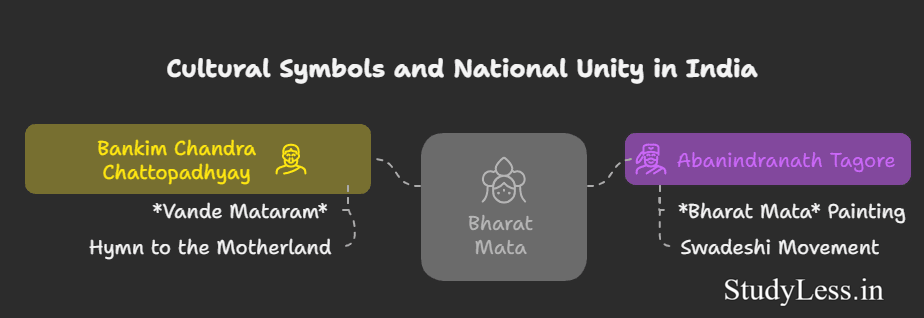
Fun Fact:
Vande Mataram became the national song after independence!
Quick Check:
- Who painted the famous Bharat Mata image?
a) Rabindranath Tagore
b) Abanindranath Tagore
c) Bankim Chandra
📖 Folklore: Stories That United India
Why Folklore?
Nationalists believed folk tales and songs held India’s true culture, damaged by British rule.
Key Players:
- Rabindranath Tagore collected Bengali ballads and rhymes.
- Natesa Sastri compiled Tamil tales in The Folklore of Southern India.
Table: Folklore Heroes
| Leader | Region | Work |
|---|---|---|
| Rabindranath Tagore | Bengal | Collected myths, nursery rhymes |
| Natesa Sastri | Madras | Published Tamil folk tales |
Thought-Provoking Question:
Can stories from your grandparents make you proud of your roots?
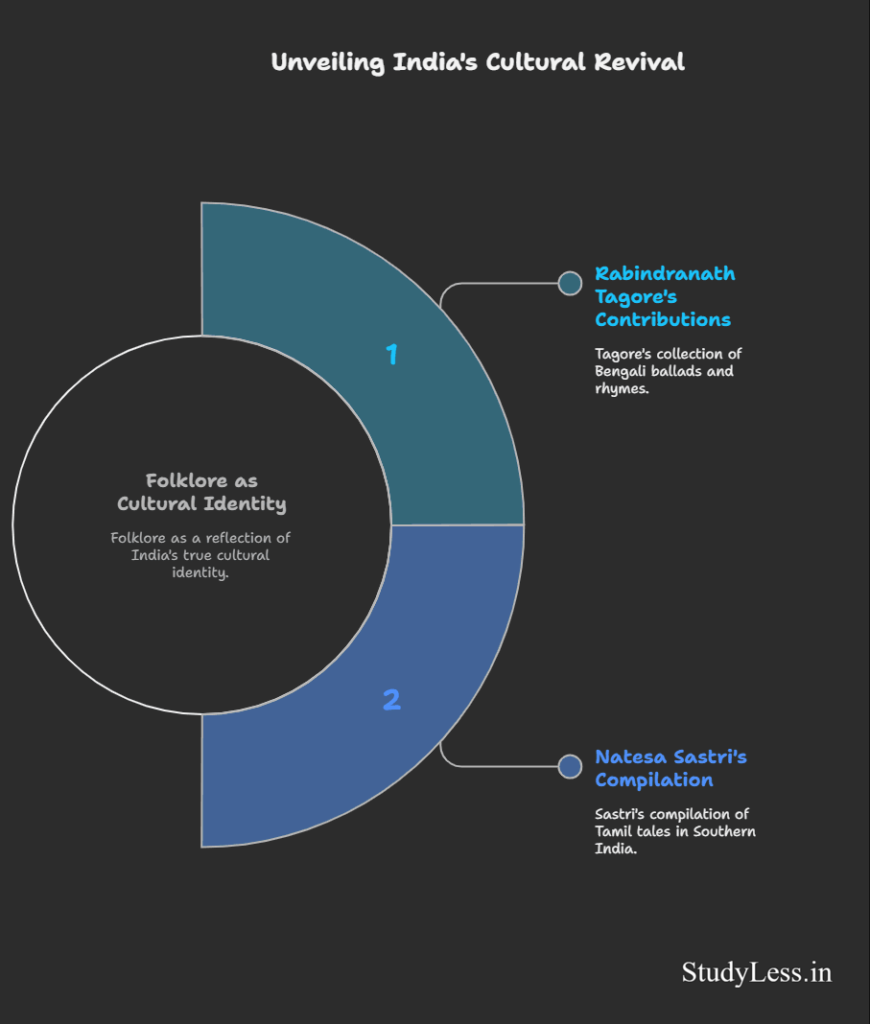
🚩 Flags: More Than Just Cloth!
Evolution of the Flag:
- Swadeshi Movement Flag (1905):
- Tricolor (red, green, yellow).
- 8 lotuses (8 provinces) + crescent moon (Hindu-Muslim unity).
- Gandhi’s Swaraj Flag (1921):
- Tricolor (red, green, white) + spinning wheel (self-reliance).
Did You Know?
Holding the flag high during marches became a symbol of defiance against the British!
Quick Check:
Assertion: The spinning wheel on the flag represented self-help.
Reason: Gandhi promoted Khadi and rural industries.
Answer: Both true! ✅
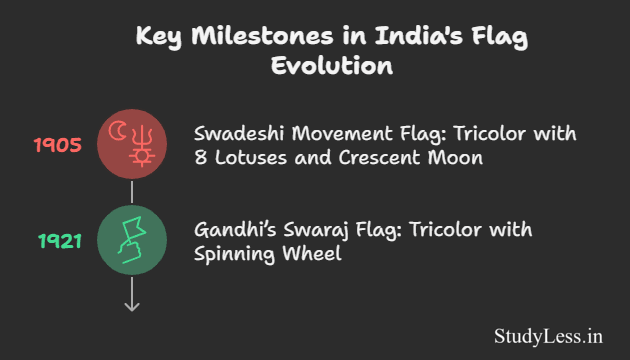
📜 Rewriting History: Pride Over Glorious Pasts
British View: “Indians are primitive and can’t govern themselves!” 😤
Indian Response: “Look at our ancient achievements!”
- Ancient India: Great in science, art, trade, philosophy.
- Medieval Decline: “British ruined this golden age!”
Example:
Aryabhata’s astronomy or the Ajanta Caves’ art were celebrated to boost pride.
Fun Fact:
The Taj Mahal was seen as proof of India’s architectural genius! 🕌
⚠️ The Problem: Not Everyone Felt Included
Hindu-Centric Symbols:
- Bharat Mata = Hindu goddess.
- Glorifying ancient Hindu kings made Muslims/Dalits feel left out.
Relatable Analogy:
If your school festival only celebrates one culture, others feel ignored!
Quick Check:
- Why did some communities feel excluded?
a) They hated flags
b) Symbols focused on Hindu culture
c) They loved British rule
🌟 Summary: Unity in Diversity?
Nationalism grew through symbols, stories, and pride – but India’s diversity made it tricky. While some felt united, others felt sidelined. The fight for freedom was also a fight to include everyone!
Food for Thought:
Can a nation truly unite if its symbols don’t represent all communities?
🌟 Unity in Diversity, Challenges in Harmony
The Indian freedom struggle was like a massive school project where everyone wanted to win but had different ideas on how to win. Let’s break down the key takeaways:
🔥 Unity Through Shared Anger
What United Everyone?
- Common Enemy: Hatred for British exploitation (high taxes, racism, unfair laws).
- Gandhi’s Leadership: Turned anger into organized movements (Non-Cooperation, Civil Disobedience).
Fun Fact:
Gandhi’s Dandi March (1930) wasn’t just about salt—it was a symbol of defiance that even a child could understand! 🧂
🧩 Diverse Aspirations: Freedom Meant Different Things
| Group | What They Wanted | Congress’s Response |
|---|---|---|
| Rich Peasants | Lower taxes, profit for cash crops | Supported tax protests but ignored post-1931 |
| Poor Peasants | Rent reduction, land ownership | Avoided “no rent” campaigns |
| Industrialists | End to British trade policies | Initially backed, but scared off by socialism |
| Dalits | Political power + end to casteism | Poona Pact (reserved seats but no separate electorates) |
| Muslims | Protection of minority rights | Failed alliances, growing distrust |
| Women | Recognition + role in freedom struggle | Symbolic participation, no leadership roles |
Thought-Provoking Question:
Could the Congress have kept everyone happy? Or was conflict inevitable?
Nationalism in India emerged as a powerful force against British rule, uniting people across regions, castes, and religions under the shared dream of Swaraj (self-rule). Leaders like Mahatma Gandhi turned protests like the Non-Cooperation and Civil Disobedience Movements into mass struggles, blending politics with moral resistance.
Symbols like Bharat Mata, the national song Vande Mataram, and the Swaraj flag stitched a collective identity, inspiring pride in India’s culture and history.
Yet, this unity had cracks. Peasants, workers, Dalits, and Muslims joined the fight but sought different freedoms—land rights, fair wages, caste equality, and minority safeguards. The Congress struggled to balance these demands, often sidelining marginalized voices to keep the movement intact.
Nationalism in India triumphed in 1947, but its true test began after independence: building a nation where freedom meant dignity and justice for all. The struggle reminds us that nationalism thrives not just in fighting outsiders, but in embracing diversity and ensuring no one is left behind.
💔 Why Unity Often Broke Down
- Conflicting Demands:
- Example: Rich peasants quit when taxes weren’t cut (1931).
- Fear of Radicalism:
- Congress sidelined workers’ strikes to please industrialists.
- Communal Tensions:
- Hindu-Muslim riots made joint struggles harder.
- British Tactics:
- Divide-and-rule policies (e.g., separate electorates).
Gandhi’s Dilemma:
“I can’t magically merge all voices into one, but I’ll try!”
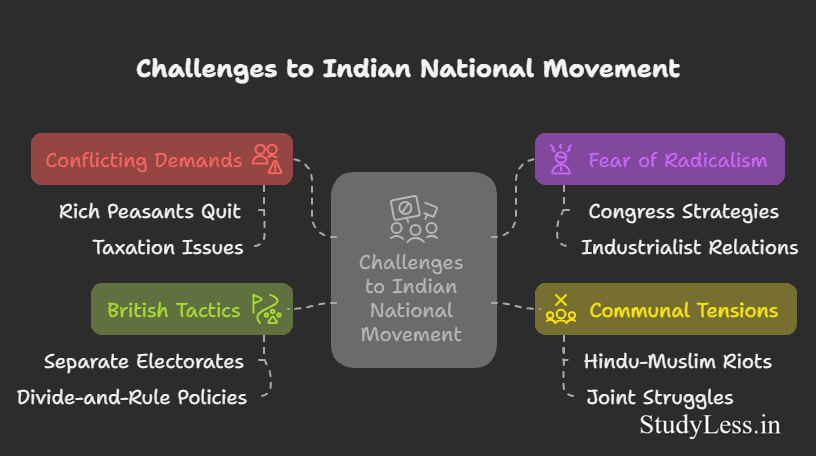
🌍 The Big Picture: A Nation of Many Voices
- Strength: Diversity made the movement rich and inclusive.
- Weakness: Differing goals led to splits (e.g., Swaraj Party vs. Radicals).
- Legacy: Despite clashes, the shared dream of Swaraj kept the struggle alive.
Quote to Ponder:
“Freedom is never dear at any price. It is the breath of life.” – Gandhi
Final Thought:
India’s freedom movement wasn’t a straight road—it was a bumpy ride with detours, but every pothole taught something new.
The takeaway?
Unity doesn’t mean uniformity; it means fighting together even when you disagree!
Conclusion: Nationalism in India – Unity in Diversity
Nationalism in India emerged as a powerful force against British rule, uniting people across regions, castes, and religions under the shared dream of Swaraj (self-rule).
Leaders like Mahatma Gandhi turned protests like the Non-Cooperation and Civil Disobedience Movements into mass struggles, blending politics with moral resistance.
Symbols like Bharat Mata, the national song Vande Mataram, and the Swaraj flag stitched a collective identity, inspiring pride in India’s culture and history.
Yet, this unity had cracks. Peasants, workers, Dalits, and Muslims joined the fight but sought different freedoms—land rights, fair wages, caste equality, and minority safeguards.
The Congress struggled to balance these demands, often sidelining marginalized voices to keep the movement intact.
Nationalism in India triumphed in 1947, but its true test began after independence: building a nation where freedom meant dignity and justice for all. The struggle reminds us that nationalism thrives not just in fighting outsiders, but in embracing diversity and ensuring no one is left behind.

FAQs – Nationalism In India
1. What is Nationalism in India?
Nationalism in India refers to the anti-colonial movement that united Indians against British rule, blending political resistance with cultural pride. Key events include the Non-Cooperation Movement and Civil Disobedience Movement.
2. What caused the rise of Nationalism in India?
The rise was fueled by British exploitation, economic hardships (e.g., WWI taxes), cultural suppression, and leaders like Gandhi who mobilized mass participation through movements like Satyagraha.
3. What was the role of Mahatma Gandhi in Nationalism in India?
Gandhi led movements like Non-Cooperation (1920) and Civil Disobedience (1930), promoting non-violence, Swadeshi, and unity across social groups.
4. Why did Gandhi start the Salt March?
The 1930 Salt March protested the British salt tax. Gandhi walked 240 miles to make salt, symbolizing defiance and sparking nationwide civil disobedience.
5. What was the impact of the Civil Disobedience Movement?
It weakened British authority through mass boycotts, tax refusal, and protests. However, it faced challenges like repression and internal divisions.
6. How did Dalits participate in Nationalism in India?
Dalits, led by B.R. Ambedkar, demanded political rights and social equality. The 1932 Poona Pact granted reserved seats but rejected separate electorates.
7. Why did Muslims distance themselves from the Congress?
Muslims feared Hindu dominance post-independence, especially after the decline of the Khilafat Movement. The Congress’s ties with Hindu groups deepened distrust.
8. What symbols united Indians during the freedom struggle?
Symbols like Bharat Mata (Mother India), Vande Mataram, and the Swaraj flag (with a spinning wheel) fostered a shared identity and cultural pride.
9. What were the limitations of the Civil Disobedience Movement?
Limitations included alienated Dalits and Muslims, business-class withdrawal, and Congress’s failure to address radical demands like “no rent” campaigns.
10. How did folklore and history shape Nationalism in India?
Nationalists revived folk tales, songs, and ancient achievements (e.g., Aryabhata’s science) to counter British narratives and instill pride in India’s heritage.

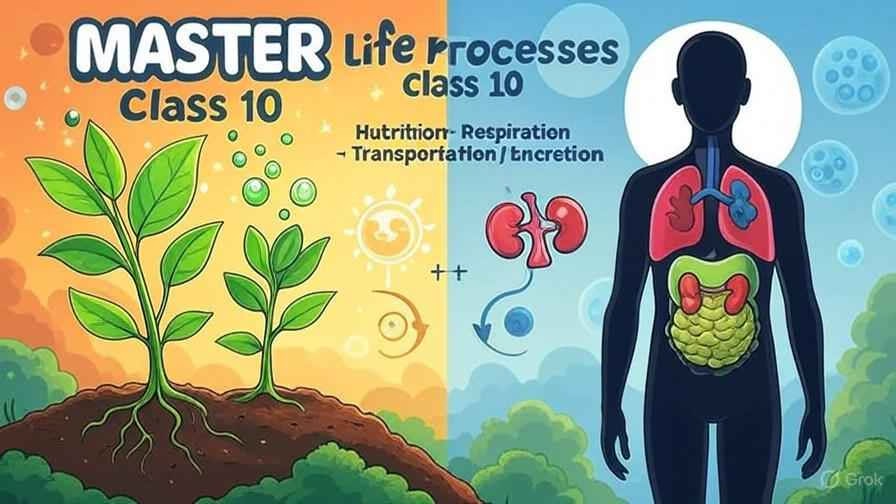
![[MCQ] First World War Khilafat and Non Cooperation Nationalism In India Quiz 2 Class 10](https://studyless.in/wp-content/uploads/2025/09/Gemini_Generated_Image_t98h59t98h59t98h_11zon-1024x559.webp)

